Three Most Effective Treatments for PTSD
VerifiedAdded on 2023/01/23
|18
|4909
|21
AI Summary
This research paper discusses the three most effective treatments for PTSD - exposure therapy, cognitive behavioral therapy, and eye movement desensitization and reprocessing therapy. It also provides information on other top therapies for PTSD.
Contribute Materials
Your contribution can guide someone’s learning journey. Share your
documents today.
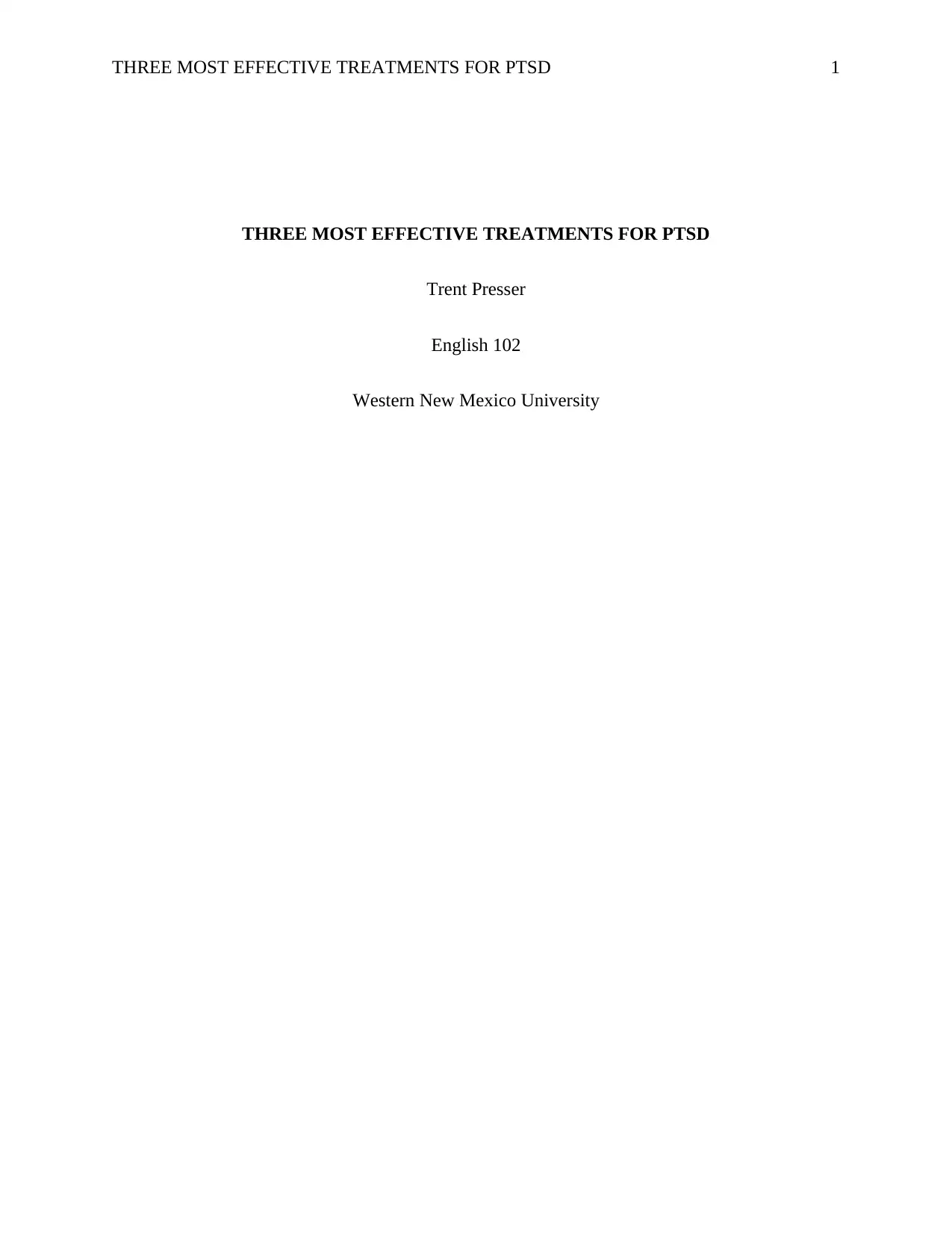
THREE MOST EFFECTIVE TREATMENTS FOR PTSD 1
THREE MOST EFFECTIVE TREATMENTS FOR PTSD
Trent Presser
English 102
Western New Mexico University
THREE MOST EFFECTIVE TREATMENTS FOR PTSD
Trent Presser
English 102
Western New Mexico University
Secure Best Marks with AI Grader
Need help grading? Try our AI Grader for instant feedback on your assignments.
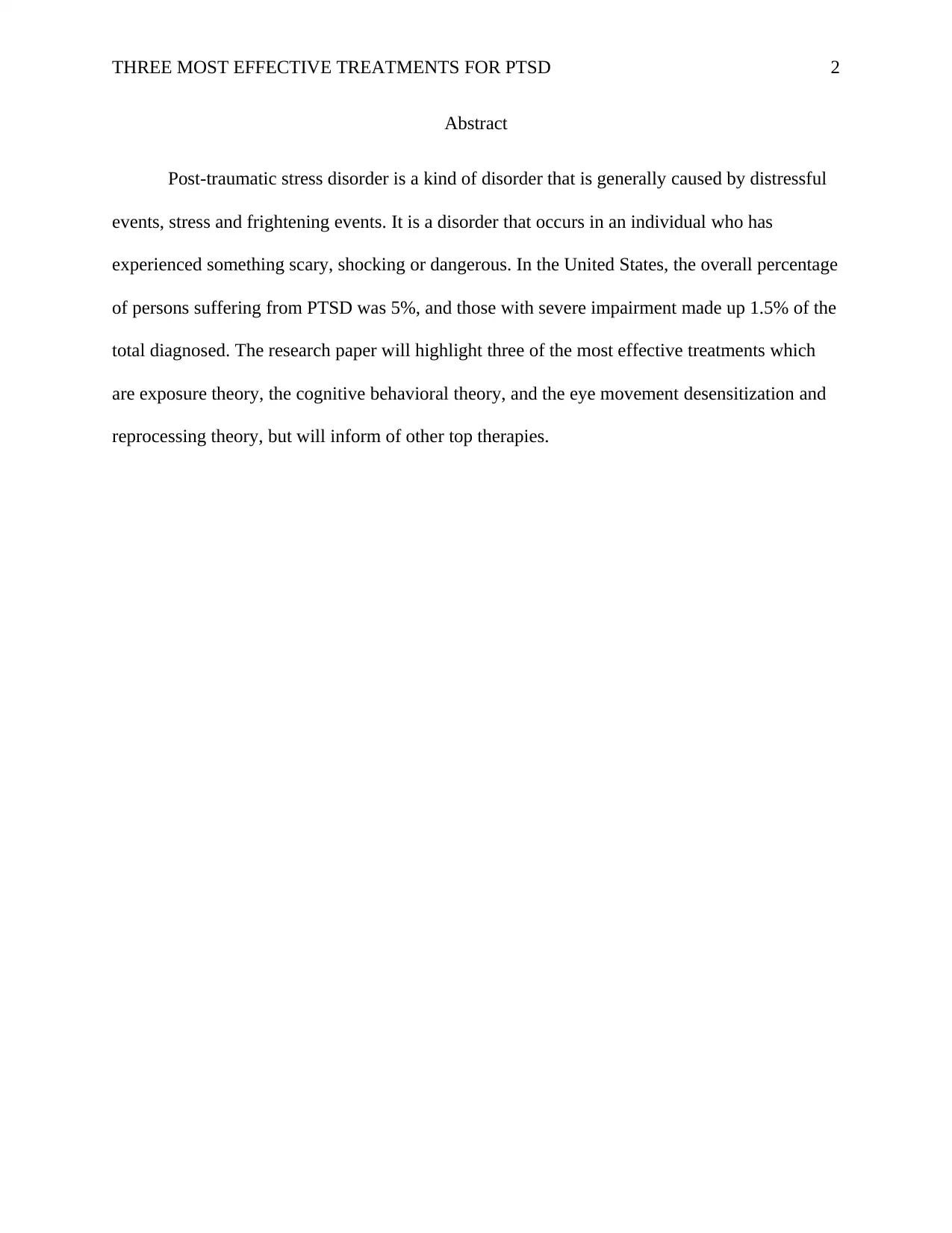
THREE MOST EFFECTIVE TREATMENTS FOR PTSD 2
Abstract
Post-traumatic stress disorder is a kind of disorder that is generally caused by distressful
events, stress and frightening events. It is a disorder that occurs in an individual who has
experienced something scary, shocking or dangerous. In the United States, the overall percentage
of persons suffering from PTSD was 5%, and those with severe impairment made up 1.5% of the
total diagnosed. The research paper will highlight three of the most effective treatments which
are exposure theory, the cognitive behavioral theory, and the eye movement desensitization and
reprocessing theory, but will inform of other top therapies.
Abstract
Post-traumatic stress disorder is a kind of disorder that is generally caused by distressful
events, stress and frightening events. It is a disorder that occurs in an individual who has
experienced something scary, shocking or dangerous. In the United States, the overall percentage
of persons suffering from PTSD was 5%, and those with severe impairment made up 1.5% of the
total diagnosed. The research paper will highlight three of the most effective treatments which
are exposure theory, the cognitive behavioral theory, and the eye movement desensitization and
reprocessing theory, but will inform of other top therapies.
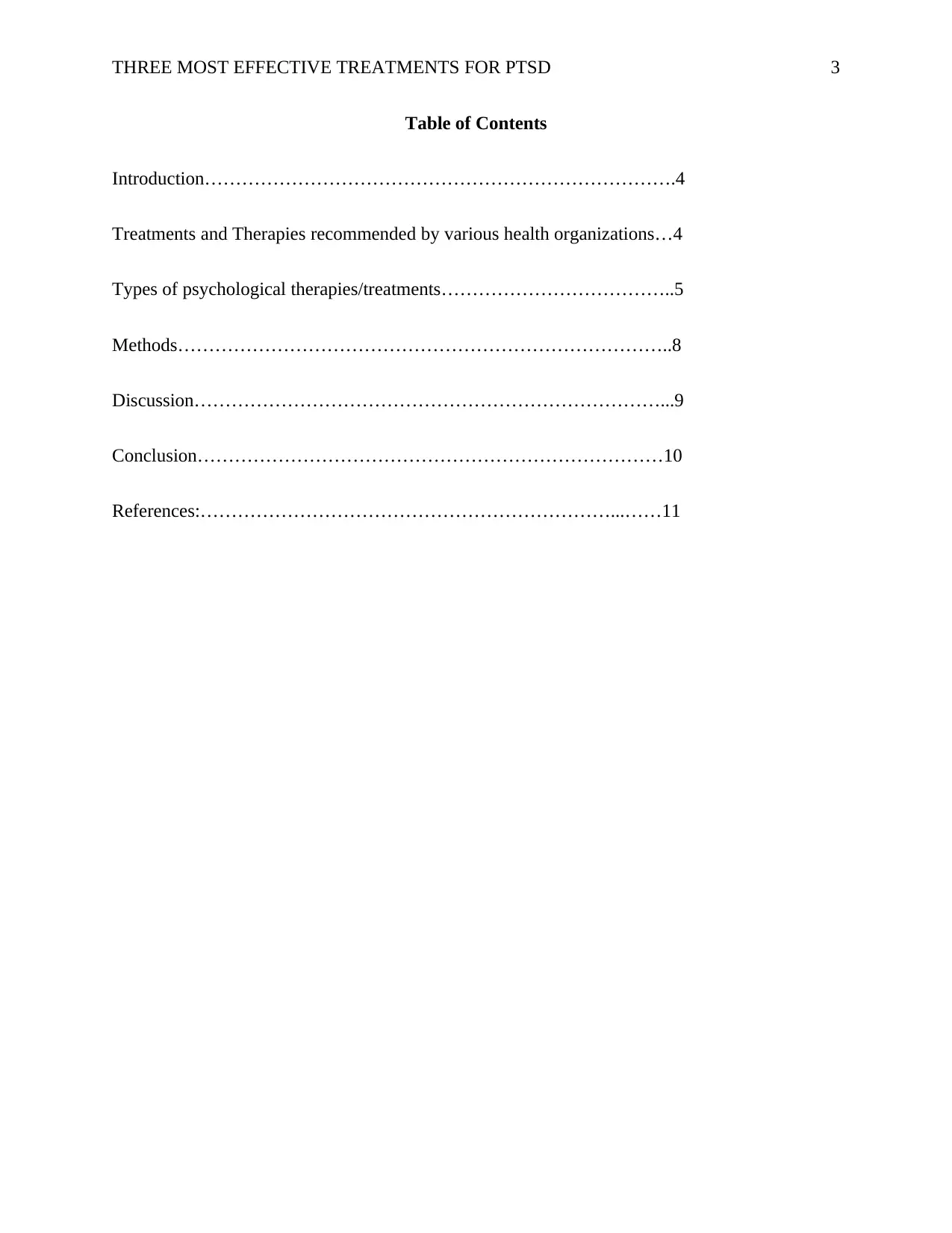
THREE MOST EFFECTIVE TREATMENTS FOR PTSD 3
Table of Contents
Introduction………………………………………………………………….4
Treatments and Therapies recommended by various health organizations…4
Types of psychological therapies/treatments………………………………..5
Methods……………………………………………………………………..8
Discussion…………………………………………………………………...9
Conclusion…………………………………………………………………10
References:…………………………………………………………...……11
Table of Contents
Introduction………………………………………………………………….4
Treatments and Therapies recommended by various health organizations…4
Types of psychological therapies/treatments………………………………..5
Methods……………………………………………………………………..8
Discussion…………………………………………………………………...9
Conclusion…………………………………………………………………10
References:…………………………………………………………...……11
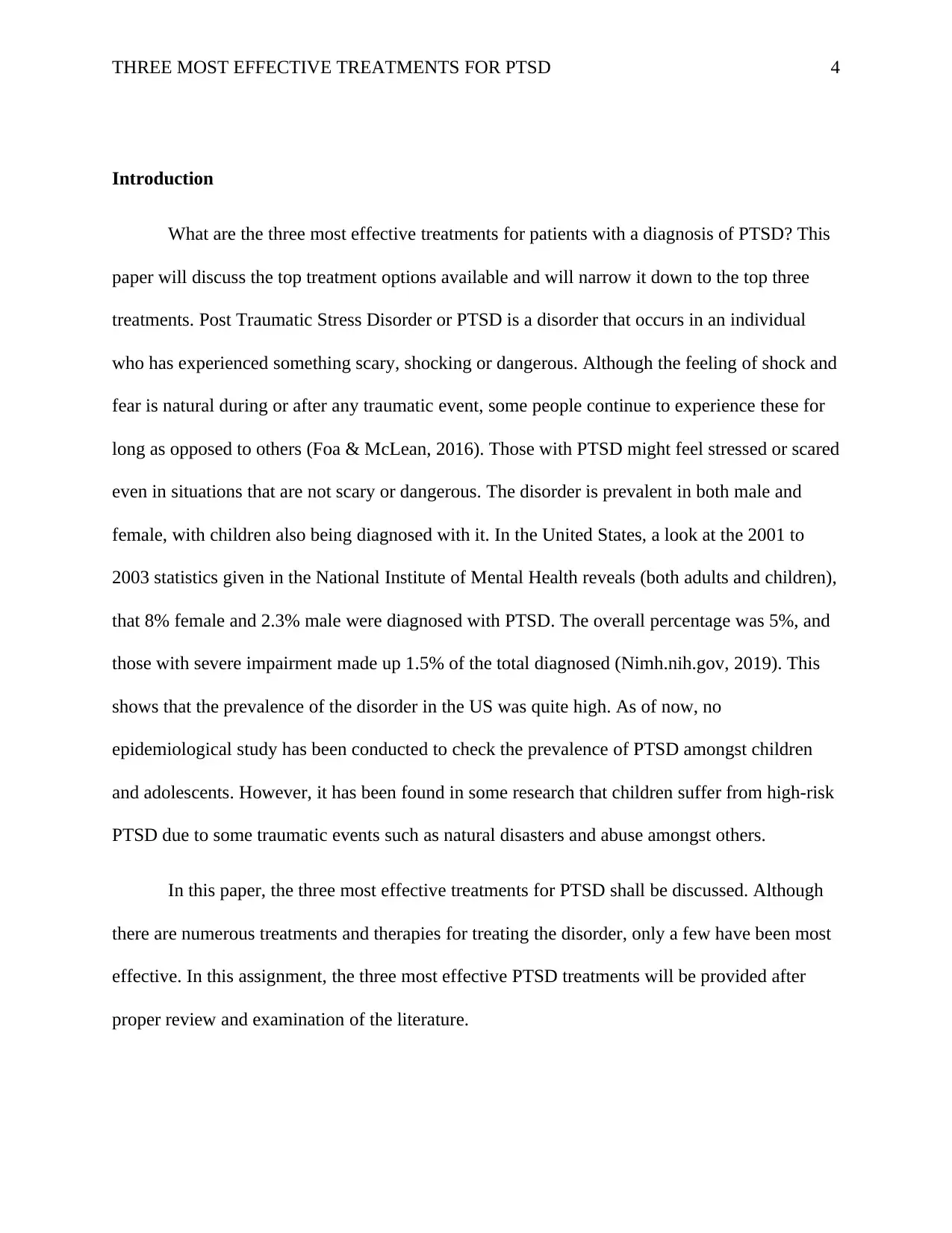
THREE MOST EFFECTIVE TREATMENTS FOR PTSD 4
Introduction
What are the three most effective treatments for patients with a diagnosis of PTSD? This
paper will discuss the top treatment options available and will narrow it down to the top three
treatments. Post Traumatic Stress Disorder or PTSD is a disorder that occurs in an individual
who has experienced something scary, shocking or dangerous. Although the feeling of shock and
fear is natural during or after any traumatic event, some people continue to experience these for
long as opposed to others (Foa & McLean, 2016). Those with PTSD might feel stressed or scared
even in situations that are not scary or dangerous. The disorder is prevalent in both male and
female, with children also being diagnosed with it. In the United States, a look at the 2001 to
2003 statistics given in the National Institute of Mental Health reveals (both adults and children),
that 8% female and 2.3% male were diagnosed with PTSD. The overall percentage was 5%, and
those with severe impairment made up 1.5% of the total diagnosed (Nimh.nih.gov, 2019). This
shows that the prevalence of the disorder in the US was quite high. As of now, no
epidemiological study has been conducted to check the prevalence of PTSD amongst children
and adolescents. However, it has been found in some research that children suffer from high-risk
PTSD due to some traumatic events such as natural disasters and abuse amongst others.
In this paper, the three most effective treatments for PTSD shall be discussed. Although
there are numerous treatments and therapies for treating the disorder, only a few have been most
effective. In this assignment, the three most effective PTSD treatments will be provided after
proper review and examination of the literature.
Introduction
What are the three most effective treatments for patients with a diagnosis of PTSD? This
paper will discuss the top treatment options available and will narrow it down to the top three
treatments. Post Traumatic Stress Disorder or PTSD is a disorder that occurs in an individual
who has experienced something scary, shocking or dangerous. Although the feeling of shock and
fear is natural during or after any traumatic event, some people continue to experience these for
long as opposed to others (Foa & McLean, 2016). Those with PTSD might feel stressed or scared
even in situations that are not scary or dangerous. The disorder is prevalent in both male and
female, with children also being diagnosed with it. In the United States, a look at the 2001 to
2003 statistics given in the National Institute of Mental Health reveals (both adults and children),
that 8% female and 2.3% male were diagnosed with PTSD. The overall percentage was 5%, and
those with severe impairment made up 1.5% of the total diagnosed (Nimh.nih.gov, 2019). This
shows that the prevalence of the disorder in the US was quite high. As of now, no
epidemiological study has been conducted to check the prevalence of PTSD amongst children
and adolescents. However, it has been found in some research that children suffer from high-risk
PTSD due to some traumatic events such as natural disasters and abuse amongst others.
In this paper, the three most effective treatments for PTSD shall be discussed. Although
there are numerous treatments and therapies for treating the disorder, only a few have been most
effective. In this assignment, the three most effective PTSD treatments will be provided after
proper review and examination of the literature.
Secure Best Marks with AI Grader
Need help grading? Try our AI Grader for instant feedback on your assignments.
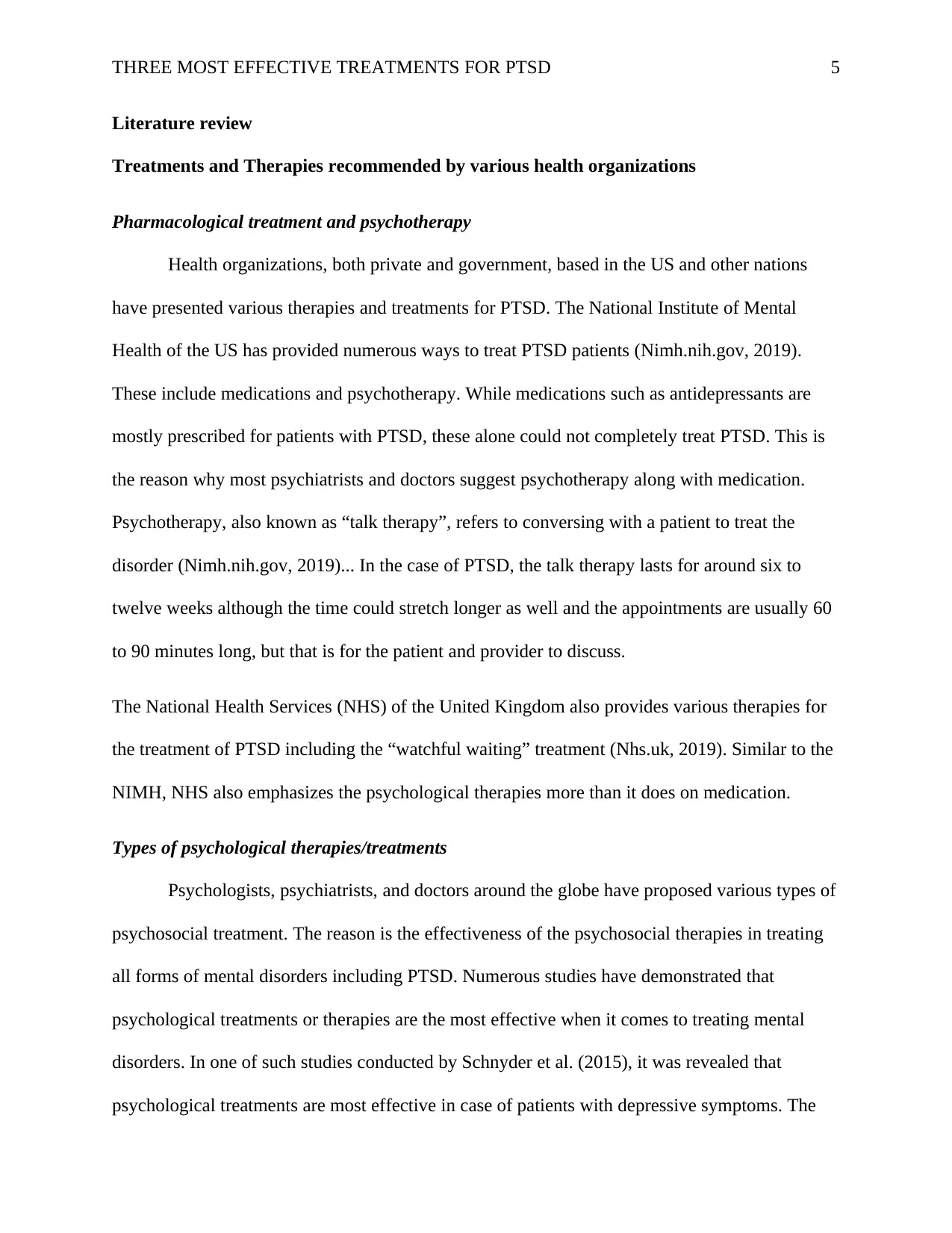
THREE MOST EFFECTIVE TREATMENTS FOR PTSD 5
Literature review
Treatments and Therapies recommended by various health organizations
Pharmacological treatment and psychotherapy
Health organizations, both private and government, based in the US and other nations
have presented various therapies and treatments for PTSD. The National Institute of Mental
Health of the US has provided numerous ways to treat PTSD patients (Nimh.nih.gov, 2019).
These include medications and psychotherapy. While medications such as antidepressants are
mostly prescribed for patients with PTSD, these alone could not completely treat PTSD. This is
the reason why most psychiatrists and doctors suggest psychotherapy along with medication.
Psychotherapy, also known as “talk therapy”, refers to conversing with a patient to treat the
disorder (Nimh.nih.gov, 2019)... In the case of PTSD, the talk therapy lasts for around six to
twelve weeks although the time could stretch longer as well and the appointments are usually 60
to 90 minutes long, but that is for the patient and provider to discuss.
The National Health Services (NHS) of the United Kingdom also provides various therapies for
the treatment of PTSD including the “watchful waiting” treatment (Nhs.uk, 2019). Similar to the
NIMH, NHS also emphasizes the psychological therapies more than it does on medication.
Types of psychological therapies/treatments
Psychologists, psychiatrists, and doctors around the globe have proposed various types of
psychosocial treatment. The reason is the effectiveness of the psychosocial therapies in treating
all forms of mental disorders including PTSD. Numerous studies have demonstrated that
psychological treatments or therapies are the most effective when it comes to treating mental
disorders. In one of such studies conducted by Schnyder et al. (2015), it was revealed that
psychological treatments are most effective in case of patients with depressive symptoms. The
Literature review
Treatments and Therapies recommended by various health organizations
Pharmacological treatment and psychotherapy
Health organizations, both private and government, based in the US and other nations
have presented various therapies and treatments for PTSD. The National Institute of Mental
Health of the US has provided numerous ways to treat PTSD patients (Nimh.nih.gov, 2019).
These include medications and psychotherapy. While medications such as antidepressants are
mostly prescribed for patients with PTSD, these alone could not completely treat PTSD. This is
the reason why most psychiatrists and doctors suggest psychotherapy along with medication.
Psychotherapy, also known as “talk therapy”, refers to conversing with a patient to treat the
disorder (Nimh.nih.gov, 2019)... In the case of PTSD, the talk therapy lasts for around six to
twelve weeks although the time could stretch longer as well and the appointments are usually 60
to 90 minutes long, but that is for the patient and provider to discuss.
The National Health Services (NHS) of the United Kingdom also provides various therapies for
the treatment of PTSD including the “watchful waiting” treatment (Nhs.uk, 2019). Similar to the
NIMH, NHS also emphasizes the psychological therapies more than it does on medication.
Types of psychological therapies/treatments
Psychologists, psychiatrists, and doctors around the globe have proposed various types of
psychosocial treatment. The reason is the effectiveness of the psychosocial therapies in treating
all forms of mental disorders including PTSD. Numerous studies have demonstrated that
psychological treatments or therapies are the most effective when it comes to treating mental
disorders. In one of such studies conducted by Schnyder et al. (2015), it was revealed that
psychological treatments are most effective in case of patients with depressive symptoms. The
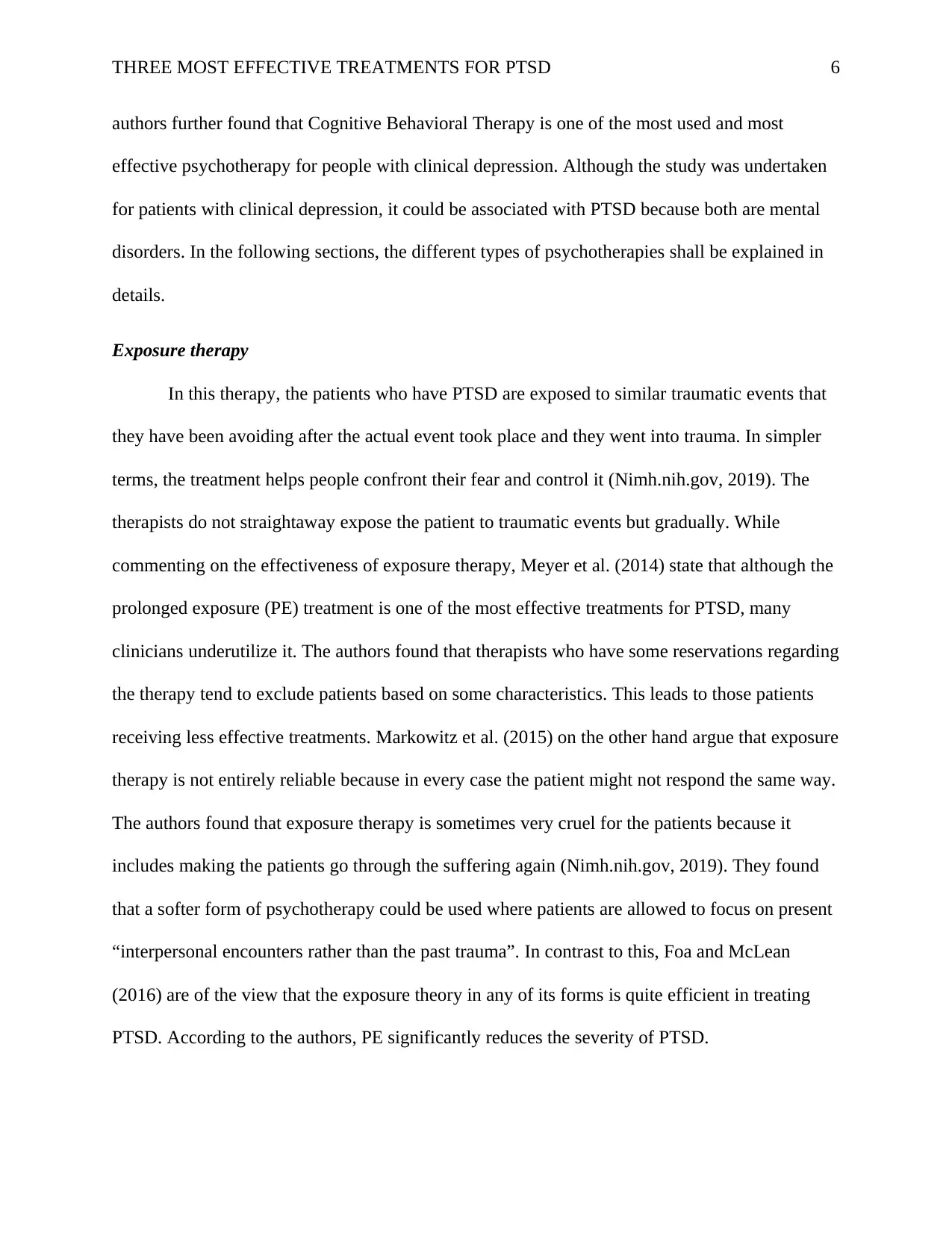
THREE MOST EFFECTIVE TREATMENTS FOR PTSD 6
authors further found that Cognitive Behavioral Therapy is one of the most used and most
effective psychotherapy for people with clinical depression. Although the study was undertaken
for patients with clinical depression, it could be associated with PTSD because both are mental
disorders. In the following sections, the different types of psychotherapies shall be explained in
details.
Exposure therapy
In this therapy, the patients who have PTSD are exposed to similar traumatic events that
they have been avoiding after the actual event took place and they went into trauma. In simpler
terms, the treatment helps people confront their fear and control it (Nimh.nih.gov, 2019). The
therapists do not straightaway expose the patient to traumatic events but gradually. While
commenting on the effectiveness of exposure therapy, Meyer et al. (2014) state that although the
prolonged exposure (PE) treatment is one of the most effective treatments for PTSD, many
clinicians underutilize it. The authors found that therapists who have some reservations regarding
the therapy tend to exclude patients based on some characteristics. This leads to those patients
receiving less effective treatments. Markowitz et al. (2015) on the other hand argue that exposure
therapy is not entirely reliable because in every case the patient might not respond the same way.
The authors found that exposure therapy is sometimes very cruel for the patients because it
includes making the patients go through the suffering again (Nimh.nih.gov, 2019). They found
that a softer form of psychotherapy could be used where patients are allowed to focus on present
“interpersonal encounters rather than the past trauma”. In contrast to this, Foa and McLean
(2016) are of the view that the exposure theory in any of its forms is quite efficient in treating
PTSD. According to the authors, PE significantly reduces the severity of PTSD.
authors further found that Cognitive Behavioral Therapy is one of the most used and most
effective psychotherapy for people with clinical depression. Although the study was undertaken
for patients with clinical depression, it could be associated with PTSD because both are mental
disorders. In the following sections, the different types of psychotherapies shall be explained in
details.
Exposure therapy
In this therapy, the patients who have PTSD are exposed to similar traumatic events that
they have been avoiding after the actual event took place and they went into trauma. In simpler
terms, the treatment helps people confront their fear and control it (Nimh.nih.gov, 2019). The
therapists do not straightaway expose the patient to traumatic events but gradually. While
commenting on the effectiveness of exposure therapy, Meyer et al. (2014) state that although the
prolonged exposure (PE) treatment is one of the most effective treatments for PTSD, many
clinicians underutilize it. The authors found that therapists who have some reservations regarding
the therapy tend to exclude patients based on some characteristics. This leads to those patients
receiving less effective treatments. Markowitz et al. (2015) on the other hand argue that exposure
therapy is not entirely reliable because in every case the patient might not respond the same way.
The authors found that exposure therapy is sometimes very cruel for the patients because it
includes making the patients go through the suffering again (Nimh.nih.gov, 2019). They found
that a softer form of psychotherapy could be used where patients are allowed to focus on present
“interpersonal encounters rather than the past trauma”. In contrast to this, Foa and McLean
(2016) are of the view that the exposure theory in any of its forms is quite efficient in treating
PTSD. According to the authors, PE significantly reduces the severity of PTSD.
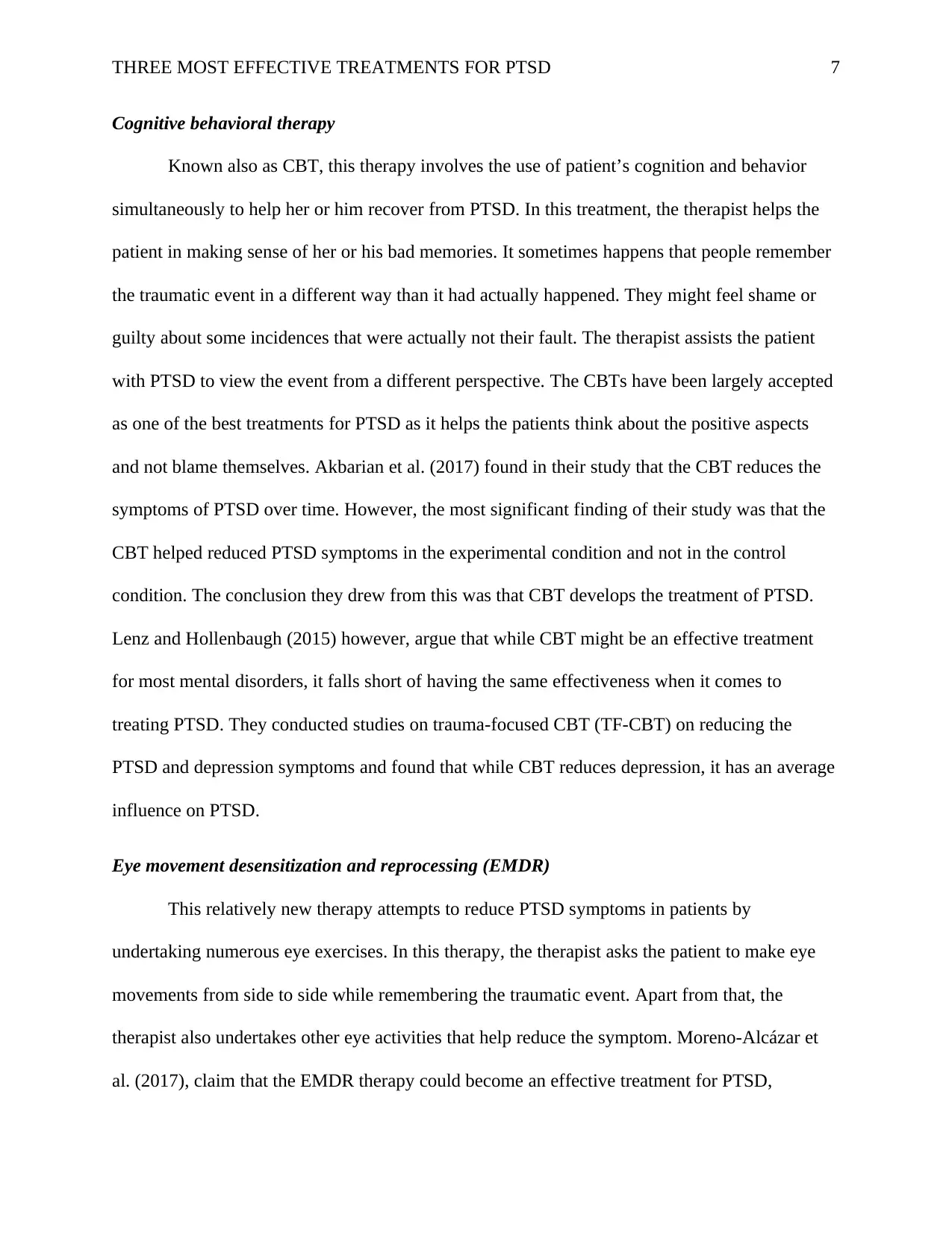
THREE MOST EFFECTIVE TREATMENTS FOR PTSD 7
Cognitive behavioral therapy
Known also as CBT, this therapy involves the use of patient’s cognition and behavior
simultaneously to help her or him recover from PTSD. In this treatment, the therapist helps the
patient in making sense of her or his bad memories. It sometimes happens that people remember
the traumatic event in a different way than it had actually happened. They might feel shame or
guilty about some incidences that were actually not their fault. The therapist assists the patient
with PTSD to view the event from a different perspective. The CBTs have been largely accepted
as one of the best treatments for PTSD as it helps the patients think about the positive aspects
and not blame themselves. Akbarian et al. (2017) found in their study that the CBT reduces the
symptoms of PTSD over time. However, the most significant finding of their study was that the
CBT helped reduced PTSD symptoms in the experimental condition and not in the control
condition. The conclusion they drew from this was that CBT develops the treatment of PTSD.
Lenz and Hollenbaugh (2015) however, argue that while CBT might be an effective treatment
for most mental disorders, it falls short of having the same effectiveness when it comes to
treating PTSD. They conducted studies on trauma-focused CBT (TF-CBT) on reducing the
PTSD and depression symptoms and found that while CBT reduces depression, it has an average
influence on PTSD.
Eye movement desensitization and reprocessing (EMDR)
This relatively new therapy attempts to reduce PTSD symptoms in patients by
undertaking numerous eye exercises. In this therapy, the therapist asks the patient to make eye
movements from side to side while remembering the traumatic event. Apart from that, the
therapist also undertakes other eye activities that help reduce the symptom. Moreno-Alcázar et
al. (2017), claim that the EMDR therapy could become an effective treatment for PTSD,
Cognitive behavioral therapy
Known also as CBT, this therapy involves the use of patient’s cognition and behavior
simultaneously to help her or him recover from PTSD. In this treatment, the therapist helps the
patient in making sense of her or his bad memories. It sometimes happens that people remember
the traumatic event in a different way than it had actually happened. They might feel shame or
guilty about some incidences that were actually not their fault. The therapist assists the patient
with PTSD to view the event from a different perspective. The CBTs have been largely accepted
as one of the best treatments for PTSD as it helps the patients think about the positive aspects
and not blame themselves. Akbarian et al. (2017) found in their study that the CBT reduces the
symptoms of PTSD over time. However, the most significant finding of their study was that the
CBT helped reduced PTSD symptoms in the experimental condition and not in the control
condition. The conclusion they drew from this was that CBT develops the treatment of PTSD.
Lenz and Hollenbaugh (2015) however, argue that while CBT might be an effective treatment
for most mental disorders, it falls short of having the same effectiveness when it comes to
treating PTSD. They conducted studies on trauma-focused CBT (TF-CBT) on reducing the
PTSD and depression symptoms and found that while CBT reduces depression, it has an average
influence on PTSD.
Eye movement desensitization and reprocessing (EMDR)
This relatively new therapy attempts to reduce PTSD symptoms in patients by
undertaking numerous eye exercises. In this therapy, the therapist asks the patient to make eye
movements from side to side while remembering the traumatic event. Apart from that, the
therapist also undertakes other eye activities that help reduce the symptom. Moreno-Alcázar et
al. (2017), claim that the EMDR therapy could become an effective treatment for PTSD,
Paraphrase This Document
Need a fresh take? Get an instant paraphrase of this document with our AI Paraphraser
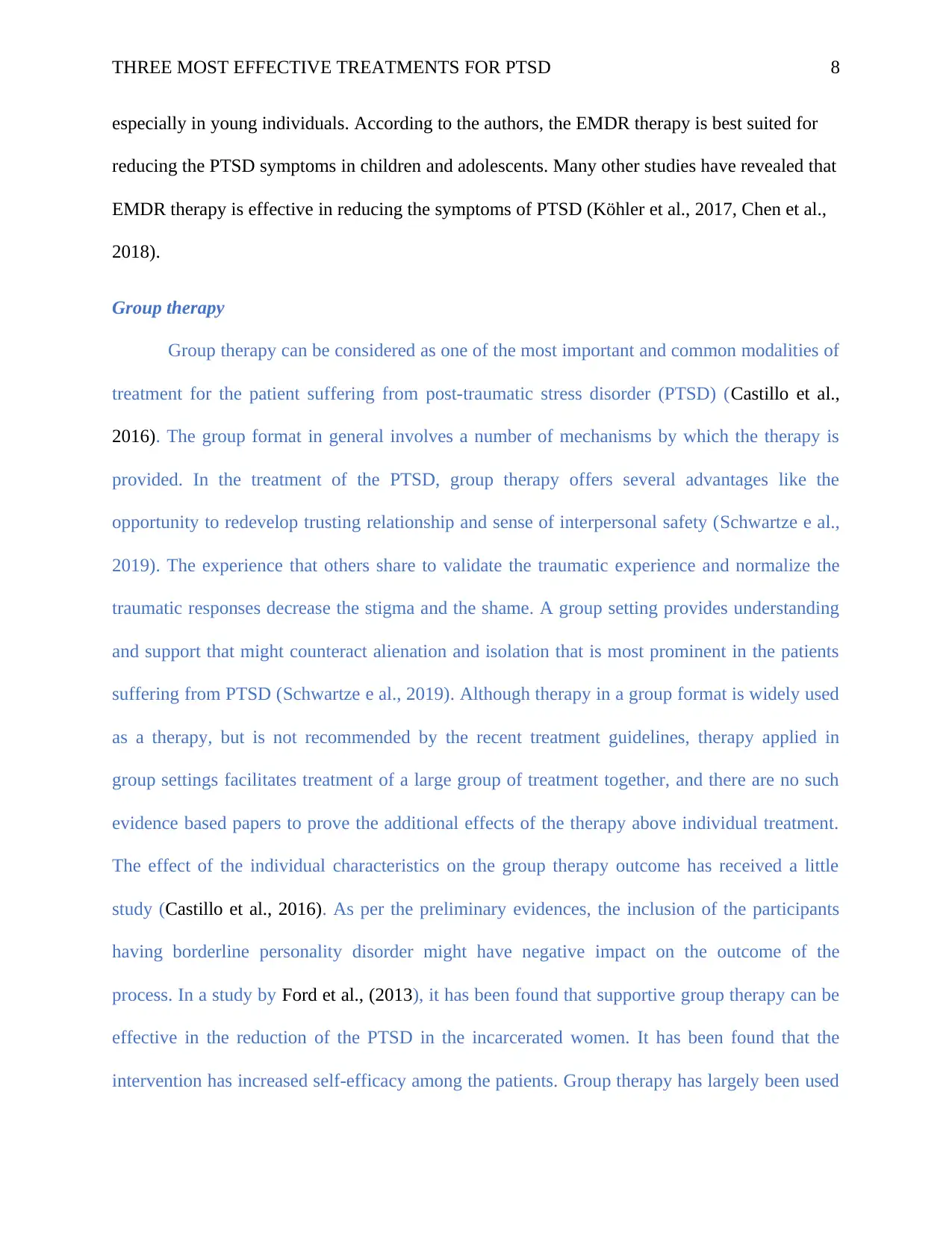
THREE MOST EFFECTIVE TREATMENTS FOR PTSD 8
especially in young individuals. According to the authors, the EMDR therapy is best suited for
reducing the PTSD symptoms in children and adolescents. Many other studies have revealed that
EMDR therapy is effective in reducing the symptoms of PTSD (Köhler et al., 2017, Chen et al.,
2018).
Group therapy
Group therapy can be considered as one of the most important and common modalities of
treatment for the patient suffering from post-traumatic stress disorder (PTSD) (Castillo et al.,
2016). The group format in general involves a number of mechanisms by which the therapy is
provided. In the treatment of the PTSD, group therapy offers several advantages like the
opportunity to redevelop trusting relationship and sense of interpersonal safety (Schwartze e al.,
2019). The experience that others share to validate the traumatic experience and normalize the
traumatic responses decrease the stigma and the shame. A group setting provides understanding
and support that might counteract alienation and isolation that is most prominent in the patients
suffering from PTSD (Schwartze e al., 2019). Although therapy in a group format is widely used
as a therapy, but is not recommended by the recent treatment guidelines, therapy applied in
group settings facilitates treatment of a large group of treatment together, and there are no such
evidence based papers to prove the additional effects of the therapy above individual treatment.
The effect of the individual characteristics on the group therapy outcome has received a little
study (Castillo et al., 2016). As per the preliminary evidences, the inclusion of the participants
having borderline personality disorder might have negative impact on the outcome of the
process. In a study by Ford et al., (2013), it has been found that supportive group therapy can be
effective in the reduction of the PTSD in the incarcerated women. It has been found that the
intervention has increased self-efficacy among the patients. Group therapy has largely been used
especially in young individuals. According to the authors, the EMDR therapy is best suited for
reducing the PTSD symptoms in children and adolescents. Many other studies have revealed that
EMDR therapy is effective in reducing the symptoms of PTSD (Köhler et al., 2017, Chen et al.,
2018).
Group therapy
Group therapy can be considered as one of the most important and common modalities of
treatment for the patient suffering from post-traumatic stress disorder (PTSD) (Castillo et al.,
2016). The group format in general involves a number of mechanisms by which the therapy is
provided. In the treatment of the PTSD, group therapy offers several advantages like the
opportunity to redevelop trusting relationship and sense of interpersonal safety (Schwartze e al.,
2019). The experience that others share to validate the traumatic experience and normalize the
traumatic responses decrease the stigma and the shame. A group setting provides understanding
and support that might counteract alienation and isolation that is most prominent in the patients
suffering from PTSD (Schwartze e al., 2019). Although therapy in a group format is widely used
as a therapy, but is not recommended by the recent treatment guidelines, therapy applied in
group settings facilitates treatment of a large group of treatment together, and there are no such
evidence based papers to prove the additional effects of the therapy above individual treatment.
The effect of the individual characteristics on the group therapy outcome has received a little
study (Castillo et al., 2016). As per the preliminary evidences, the inclusion of the participants
having borderline personality disorder might have negative impact on the outcome of the
process. In a study by Ford et al., (2013), it has been found that supportive group therapy can be
effective in the reduction of the PTSD in the incarcerated women. It has been found that the
intervention has increased self-efficacy among the patients. Group therapy has largely been used
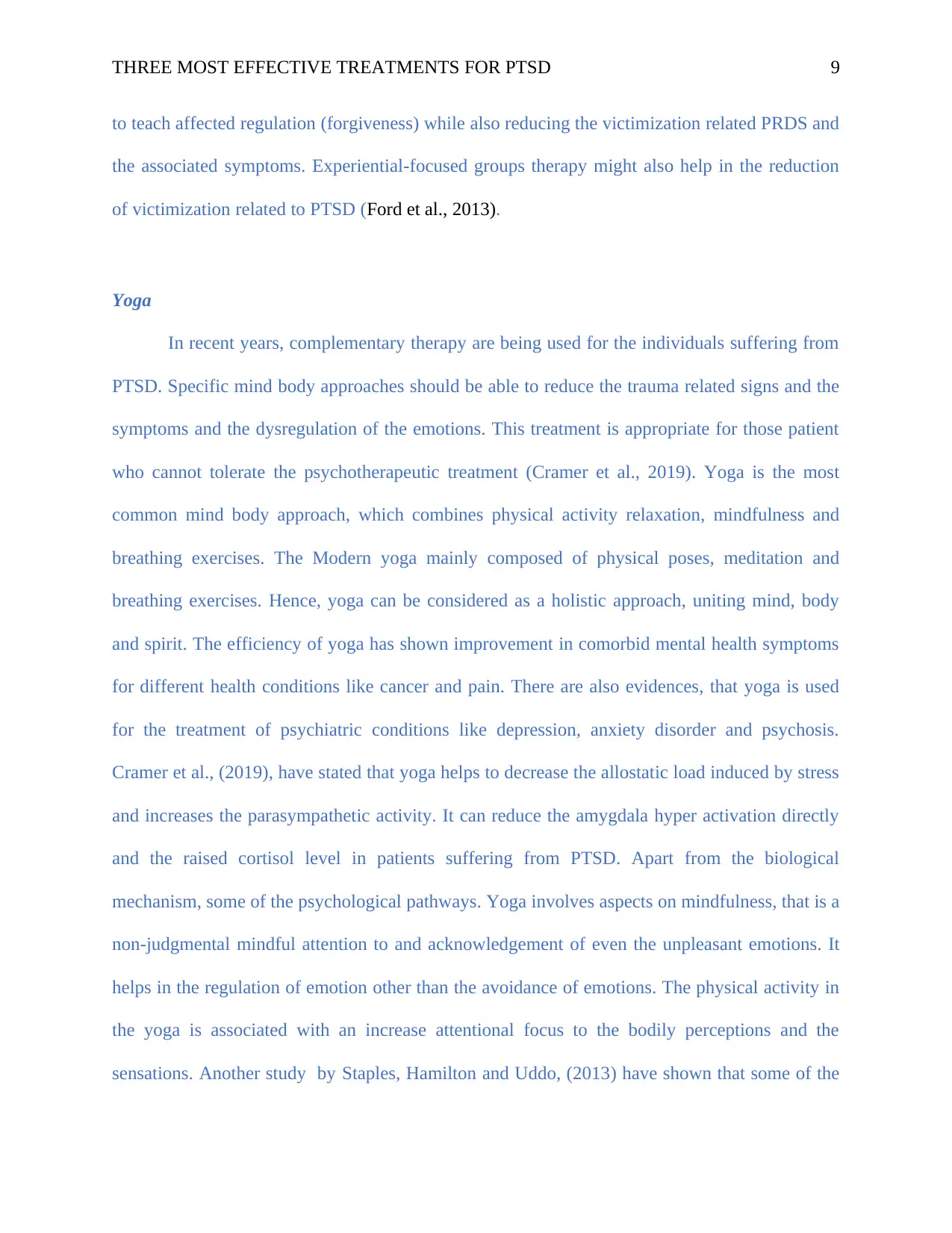
THREE MOST EFFECTIVE TREATMENTS FOR PTSD 9
to teach affected regulation (forgiveness) while also reducing the victimization related PRDS and
the associated symptoms. Experiential-focused groups therapy might also help in the reduction
of victimization related to PTSD (Ford et al., 2013).
Yoga
In recent years, complementary therapy are being used for the individuals suffering from
PTSD. Specific mind body approaches should be able to reduce the trauma related signs and the
symptoms and the dysregulation of the emotions. This treatment is appropriate for those patient
who cannot tolerate the psychotherapeutic treatment (Cramer et al., 2019). Yoga is the most
common mind body approach, which combines physical activity relaxation, mindfulness and
breathing exercises. The Modern yoga mainly composed of physical poses, meditation and
breathing exercises. Hence, yoga can be considered as a holistic approach, uniting mind, body
and spirit. The efficiency of yoga has shown improvement in comorbid mental health symptoms
for different health conditions like cancer and pain. There are also evidences, that yoga is used
for the treatment of psychiatric conditions like depression, anxiety disorder and psychosis.
Cramer et al., (2019), have stated that yoga helps to decrease the allostatic load induced by stress
and increases the parasympathetic activity. It can reduce the amygdala hyper activation directly
and the raised cortisol level in patients suffering from PTSD. Apart from the biological
mechanism, some of the psychological pathways. Yoga involves aspects on mindfulness, that is a
non-judgmental mindful attention to and acknowledgement of even the unpleasant emotions. It
helps in the regulation of emotion other than the avoidance of emotions. The physical activity in
the yoga is associated with an increase attentional focus to the bodily perceptions and the
sensations. Another study by Staples, Hamilton and Uddo, (2013) have shown that some of the
to teach affected regulation (forgiveness) while also reducing the victimization related PRDS and
the associated symptoms. Experiential-focused groups therapy might also help in the reduction
of victimization related to PTSD (Ford et al., 2013).
Yoga
In recent years, complementary therapy are being used for the individuals suffering from
PTSD. Specific mind body approaches should be able to reduce the trauma related signs and the
symptoms and the dysregulation of the emotions. This treatment is appropriate for those patient
who cannot tolerate the psychotherapeutic treatment (Cramer et al., 2019). Yoga is the most
common mind body approach, which combines physical activity relaxation, mindfulness and
breathing exercises. The Modern yoga mainly composed of physical poses, meditation and
breathing exercises. Hence, yoga can be considered as a holistic approach, uniting mind, body
and spirit. The efficiency of yoga has shown improvement in comorbid mental health symptoms
for different health conditions like cancer and pain. There are also evidences, that yoga is used
for the treatment of psychiatric conditions like depression, anxiety disorder and psychosis.
Cramer et al., (2019), have stated that yoga helps to decrease the allostatic load induced by stress
and increases the parasympathetic activity. It can reduce the amygdala hyper activation directly
and the raised cortisol level in patients suffering from PTSD. Apart from the biological
mechanism, some of the psychological pathways. Yoga involves aspects on mindfulness, that is a
non-judgmental mindful attention to and acknowledgement of even the unpleasant emotions. It
helps in the regulation of emotion other than the avoidance of emotions. The physical activity in
the yoga is associated with an increase attentional focus to the bodily perceptions and the
sensations. Another study by Staples, Hamilton and Uddo, (2013) have shown that some of the
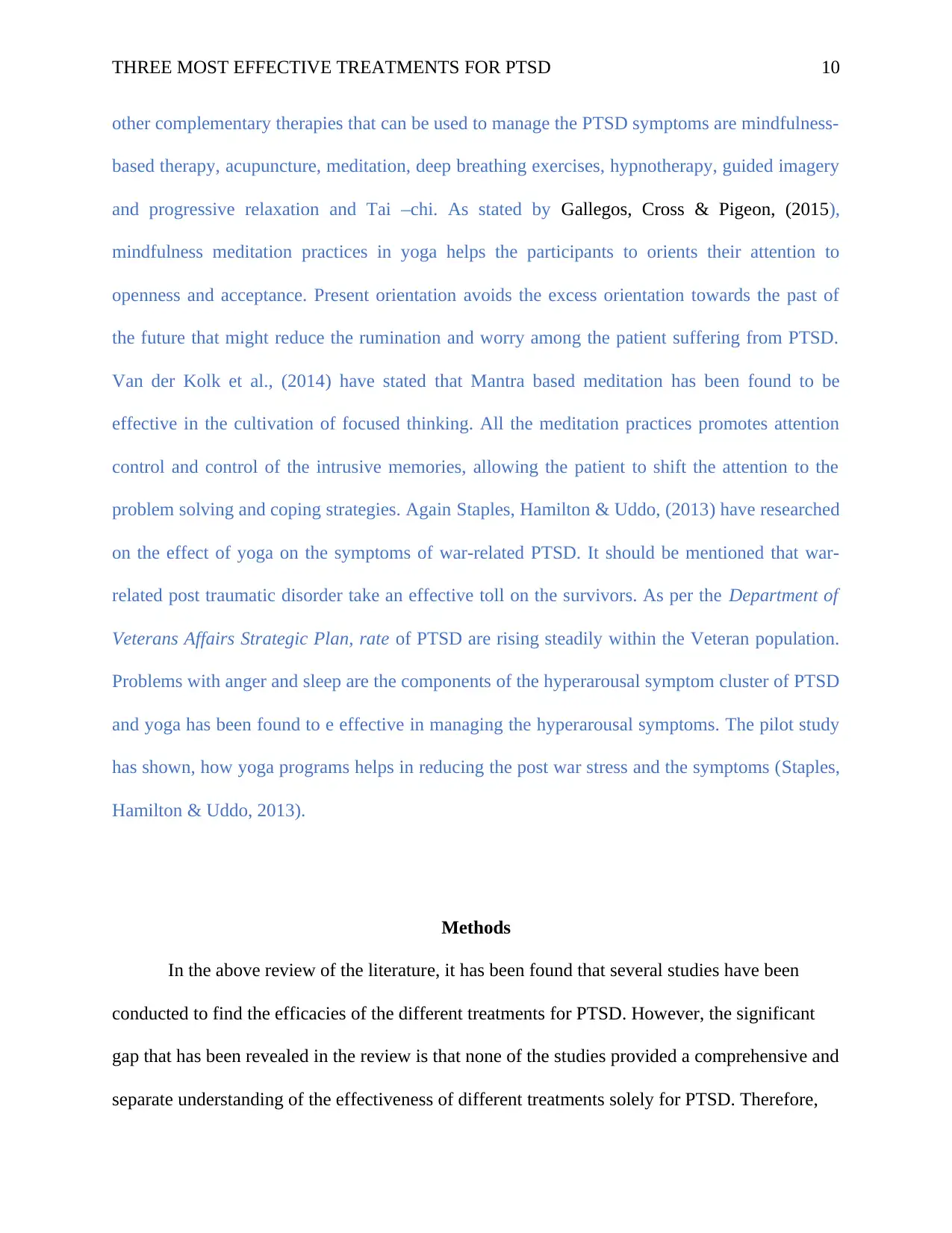
THREE MOST EFFECTIVE TREATMENTS FOR PTSD 10
other complementary therapies that can be used to manage the PTSD symptoms are mindfulness-
based therapy, acupuncture, meditation, deep breathing exercises, hypnotherapy, guided imagery
and progressive relaxation and Tai –chi. As stated by Gallegos, Cross & Pigeon, (2015),
mindfulness meditation practices in yoga helps the participants to orients their attention to
openness and acceptance. Present orientation avoids the excess orientation towards the past of
the future that might reduce the rumination and worry among the patient suffering from PTSD.
Van der Kolk et al., (2014) have stated that Mantra based meditation has been found to be
effective in the cultivation of focused thinking. All the meditation practices promotes attention
control and control of the intrusive memories, allowing the patient to shift the attention to the
problem solving and coping strategies. Again Staples, Hamilton & Uddo, (2013) have researched
on the effect of yoga on the symptoms of war-related PTSD. It should be mentioned that war-
related post traumatic disorder take an effective toll on the survivors. As per the Department of
Veterans Affairs Strategic Plan, rate of PTSD are rising steadily within the Veteran population.
Problems with anger and sleep are the components of the hyperarousal symptom cluster of PTSD
and yoga has been found to e effective in managing the hyperarousal symptoms. The pilot study
has shown, how yoga programs helps in reducing the post war stress and the symptoms (Staples,
Hamilton & Uddo, 2013).
Methods
In the above review of the literature, it has been found that several studies have been
conducted to find the efficacies of the different treatments for PTSD. However, the significant
gap that has been revealed in the review is that none of the studies provided a comprehensive and
separate understanding of the effectiveness of different treatments solely for PTSD. Therefore,
other complementary therapies that can be used to manage the PTSD symptoms are mindfulness-
based therapy, acupuncture, meditation, deep breathing exercises, hypnotherapy, guided imagery
and progressive relaxation and Tai –chi. As stated by Gallegos, Cross & Pigeon, (2015),
mindfulness meditation practices in yoga helps the participants to orients their attention to
openness and acceptance. Present orientation avoids the excess orientation towards the past of
the future that might reduce the rumination and worry among the patient suffering from PTSD.
Van der Kolk et al., (2014) have stated that Mantra based meditation has been found to be
effective in the cultivation of focused thinking. All the meditation practices promotes attention
control and control of the intrusive memories, allowing the patient to shift the attention to the
problem solving and coping strategies. Again Staples, Hamilton & Uddo, (2013) have researched
on the effect of yoga on the symptoms of war-related PTSD. It should be mentioned that war-
related post traumatic disorder take an effective toll on the survivors. As per the Department of
Veterans Affairs Strategic Plan, rate of PTSD are rising steadily within the Veteran population.
Problems with anger and sleep are the components of the hyperarousal symptom cluster of PTSD
and yoga has been found to e effective in managing the hyperarousal symptoms. The pilot study
has shown, how yoga programs helps in reducing the post war stress and the symptoms (Staples,
Hamilton & Uddo, 2013).
Methods
In the above review of the literature, it has been found that several studies have been
conducted to find the efficacies of the different treatments for PTSD. However, the significant
gap that has been revealed in the review is that none of the studies provided a comprehensive and
separate understanding of the effectiveness of different treatments solely for PTSD. Therefore,
Secure Best Marks with AI Grader
Need help grading? Try our AI Grader for instant feedback on your assignments.
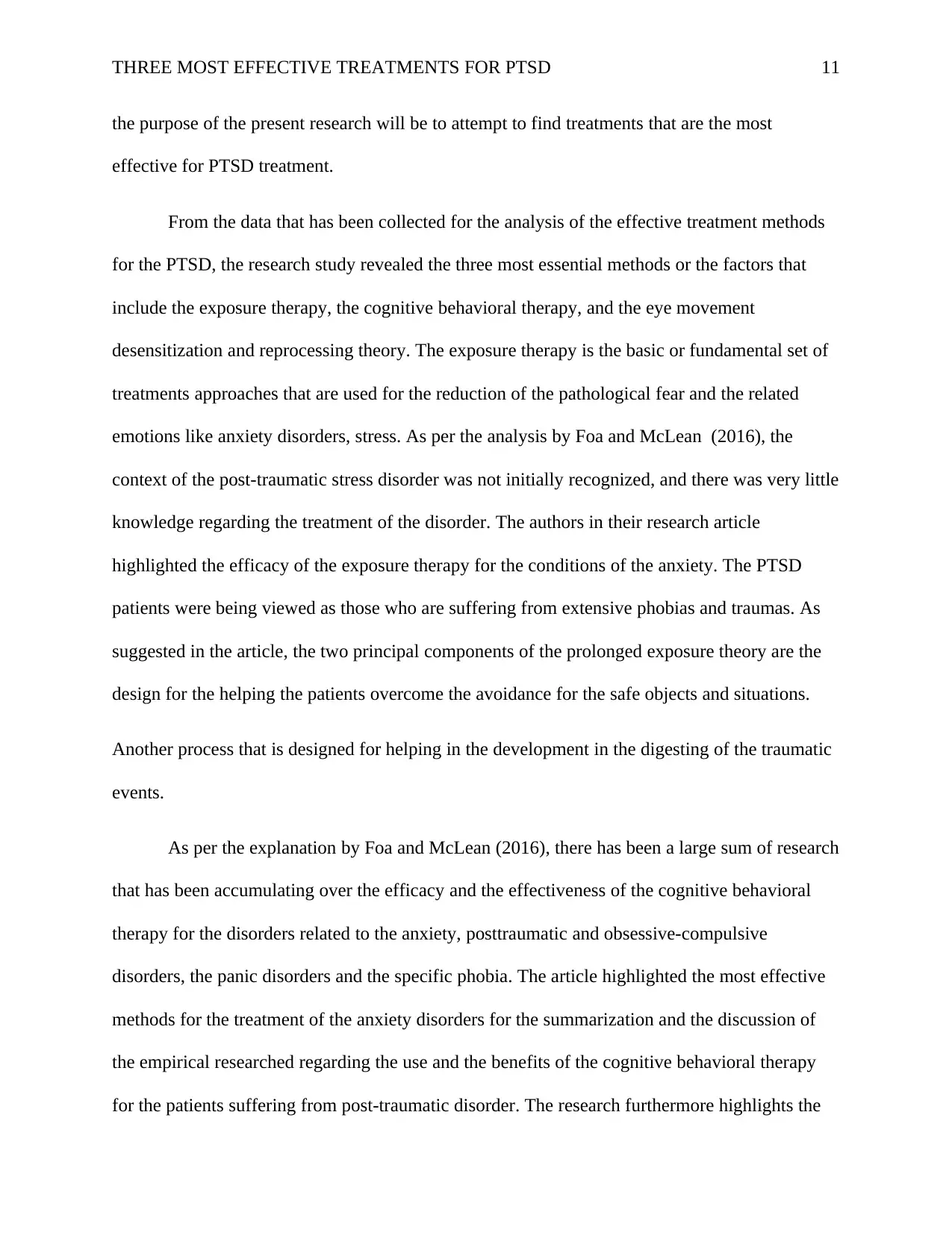
THREE MOST EFFECTIVE TREATMENTS FOR PTSD 11
the purpose of the present research will be to attempt to find treatments that are the most
effective for PTSD treatment.
From the data that has been collected for the analysis of the effective treatment methods
for the PTSD, the research study revealed the three most essential methods or the factors that
include the exposure therapy, the cognitive behavioral therapy, and the eye movement
desensitization and reprocessing theory. The exposure therapy is the basic or fundamental set of
treatments approaches that are used for the reduction of the pathological fear and the related
emotions like anxiety disorders, stress. As per the analysis by Foa and McLean (2016), the
context of the post-traumatic stress disorder was not initially recognized, and there was very little
knowledge regarding the treatment of the disorder. The authors in their research article
highlighted the efficacy of the exposure therapy for the conditions of the anxiety. The PTSD
patients were being viewed as those who are suffering from extensive phobias and traumas. As
suggested in the article, the two principal components of the prolonged exposure theory are the
design for the helping the patients overcome the avoidance for the safe objects and situations.
Another process that is designed for helping in the development in the digesting of the traumatic
events.
As per the explanation by Foa and McLean (2016), there has been a large sum of research
that has been accumulating over the efficacy and the effectiveness of the cognitive behavioral
therapy for the disorders related to the anxiety, posttraumatic and obsessive-compulsive
disorders, the panic disorders and the specific phobia. The article highlighted the most effective
methods for the treatment of the anxiety disorders for the summarization and the discussion of
the empirical researched regarding the use and the benefits of the cognitive behavioral therapy
for the patients suffering from post-traumatic disorder. The research furthermore highlights the
the purpose of the present research will be to attempt to find treatments that are the most
effective for PTSD treatment.
From the data that has been collected for the analysis of the effective treatment methods
for the PTSD, the research study revealed the three most essential methods or the factors that
include the exposure therapy, the cognitive behavioral therapy, and the eye movement
desensitization and reprocessing theory. The exposure therapy is the basic or fundamental set of
treatments approaches that are used for the reduction of the pathological fear and the related
emotions like anxiety disorders, stress. As per the analysis by Foa and McLean (2016), the
context of the post-traumatic stress disorder was not initially recognized, and there was very little
knowledge regarding the treatment of the disorder. The authors in their research article
highlighted the efficacy of the exposure therapy for the conditions of the anxiety. The PTSD
patients were being viewed as those who are suffering from extensive phobias and traumas. As
suggested in the article, the two principal components of the prolonged exposure theory are the
design for the helping the patients overcome the avoidance for the safe objects and situations.
Another process that is designed for helping in the development in the digesting of the traumatic
events.
As per the explanation by Foa and McLean (2016), there has been a large sum of research
that has been accumulating over the efficacy and the effectiveness of the cognitive behavioral
therapy for the disorders related to the anxiety, posttraumatic and obsessive-compulsive
disorders, the panic disorders and the specific phobia. The article highlighted the most effective
methods for the treatment of the anxiety disorders for the summarization and the discussion of
the empirical researched regarding the use and the benefits of the cognitive behavioral therapy
for the patients suffering from post-traumatic disorder. The research furthermore highlights the
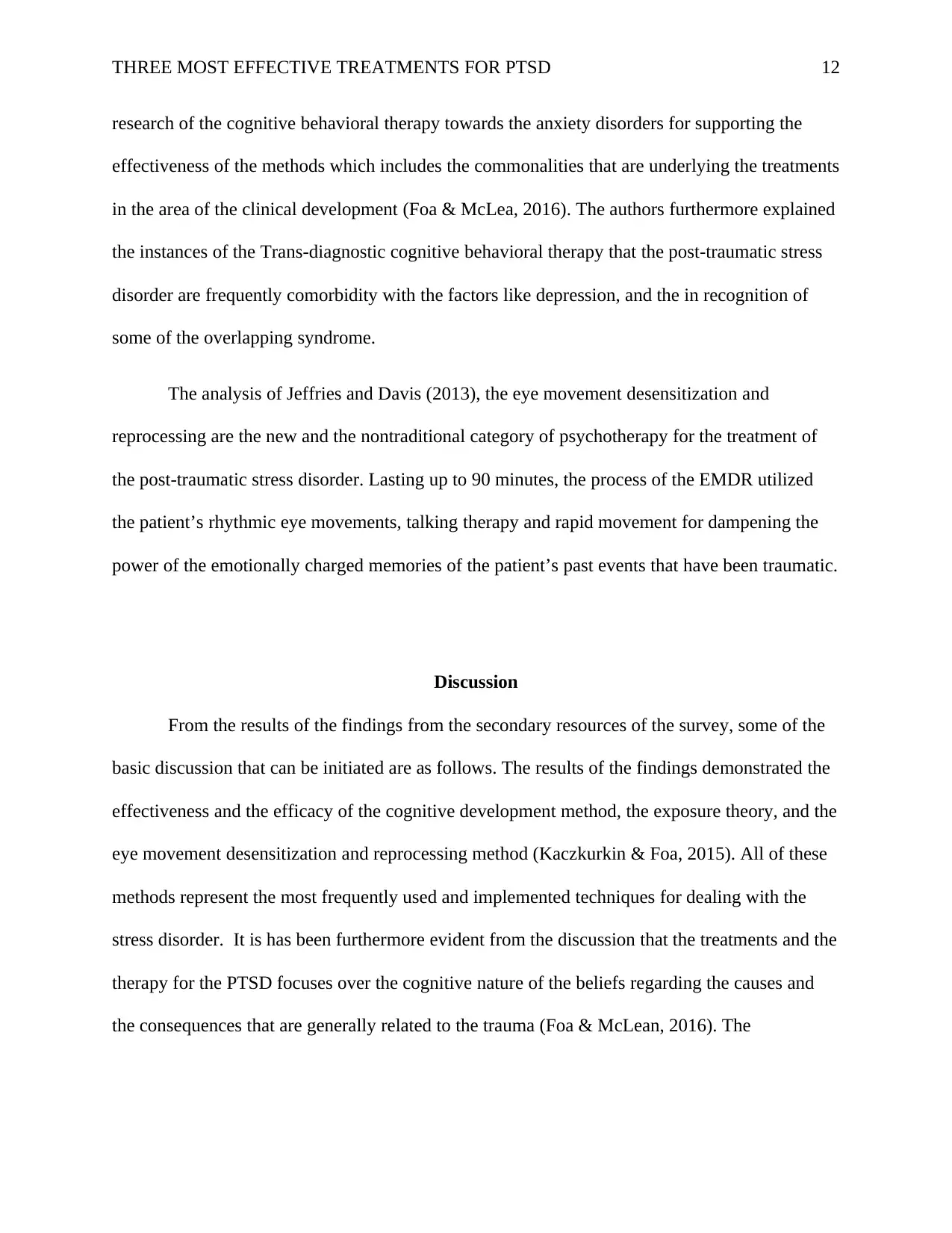
THREE MOST EFFECTIVE TREATMENTS FOR PTSD 12
research of the cognitive behavioral therapy towards the anxiety disorders for supporting the
effectiveness of the methods which includes the commonalities that are underlying the treatments
in the area of the clinical development (Foa & McLea, 2016). The authors furthermore explained
the instances of the Trans-diagnostic cognitive behavioral therapy that the post-traumatic stress
disorder are frequently comorbidity with the factors like depression, and the in recognition of
some of the overlapping syndrome.
The analysis of Jeffries and Davis (2013), the eye movement desensitization and
reprocessing are the new and the nontraditional category of psychotherapy for the treatment of
the post-traumatic stress disorder. Lasting up to 90 minutes, the process of the EMDR utilized
the patient’s rhythmic eye movements, talking therapy and rapid movement for dampening the
power of the emotionally charged memories of the patient’s past events that have been traumatic.
Discussion
From the results of the findings from the secondary resources of the survey, some of the
basic discussion that can be initiated are as follows. The results of the findings demonstrated the
effectiveness and the efficacy of the cognitive development method, the exposure theory, and the
eye movement desensitization and reprocessing method (Kaczkurkin & Foa, 2015). All of these
methods represent the most frequently used and implemented techniques for dealing with the
stress disorder. It is has been furthermore evident from the discussion that the treatments and the
therapy for the PTSD focuses over the cognitive nature of the beliefs regarding the causes and
the consequences that are generally related to the trauma (Foa & McLean, 2016). The
research of the cognitive behavioral therapy towards the anxiety disorders for supporting the
effectiveness of the methods which includes the commonalities that are underlying the treatments
in the area of the clinical development (Foa & McLea, 2016). The authors furthermore explained
the instances of the Trans-diagnostic cognitive behavioral therapy that the post-traumatic stress
disorder are frequently comorbidity with the factors like depression, and the in recognition of
some of the overlapping syndrome.
The analysis of Jeffries and Davis (2013), the eye movement desensitization and
reprocessing are the new and the nontraditional category of psychotherapy for the treatment of
the post-traumatic stress disorder. Lasting up to 90 minutes, the process of the EMDR utilized
the patient’s rhythmic eye movements, talking therapy and rapid movement for dampening the
power of the emotionally charged memories of the patient’s past events that have been traumatic.
Discussion
From the results of the findings from the secondary resources of the survey, some of the
basic discussion that can be initiated are as follows. The results of the findings demonstrated the
effectiveness and the efficacy of the cognitive development method, the exposure theory, and the
eye movement desensitization and reprocessing method (Kaczkurkin & Foa, 2015). All of these
methods represent the most frequently used and implemented techniques for dealing with the
stress disorder. It is has been furthermore evident from the discussion that the treatments and the
therapy for the PTSD focuses over the cognitive nature of the beliefs regarding the causes and
the consequences that are generally related to the trauma (Foa & McLean, 2016). The
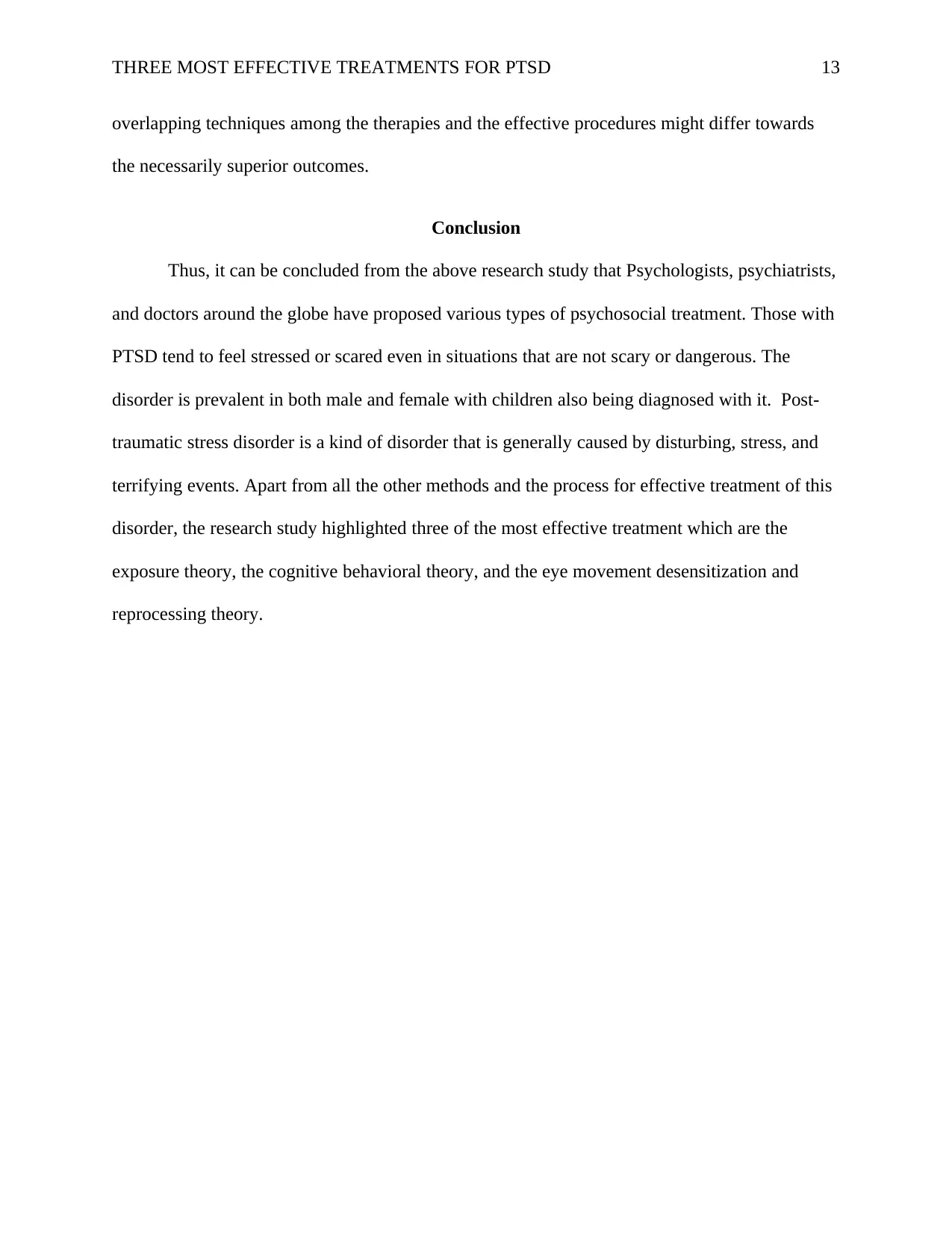
THREE MOST EFFECTIVE TREATMENTS FOR PTSD 13
overlapping techniques among the therapies and the effective procedures might differ towards
the necessarily superior outcomes.
Conclusion
Thus, it can be concluded from the above research study that Psychologists, psychiatrists,
and doctors around the globe have proposed various types of psychosocial treatment. Those with
PTSD tend to feel stressed or scared even in situations that are not scary or dangerous. The
disorder is prevalent in both male and female with children also being diagnosed with it. Post-
traumatic stress disorder is a kind of disorder that is generally caused by disturbing, stress, and
terrifying events. Apart from all the other methods and the process for effective treatment of this
disorder, the research study highlighted three of the most effective treatment which are the
exposure theory, the cognitive behavioral theory, and the eye movement desensitization and
reprocessing theory.
overlapping techniques among the therapies and the effective procedures might differ towards
the necessarily superior outcomes.
Conclusion
Thus, it can be concluded from the above research study that Psychologists, psychiatrists,
and doctors around the globe have proposed various types of psychosocial treatment. Those with
PTSD tend to feel stressed or scared even in situations that are not scary or dangerous. The
disorder is prevalent in both male and female with children also being diagnosed with it. Post-
traumatic stress disorder is a kind of disorder that is generally caused by disturbing, stress, and
terrifying events. Apart from all the other methods and the process for effective treatment of this
disorder, the research study highlighted three of the most effective treatment which are the
exposure theory, the cognitive behavioral theory, and the eye movement desensitization and
reprocessing theory.
Paraphrase This Document
Need a fresh take? Get an instant paraphrase of this document with our AI Paraphraser
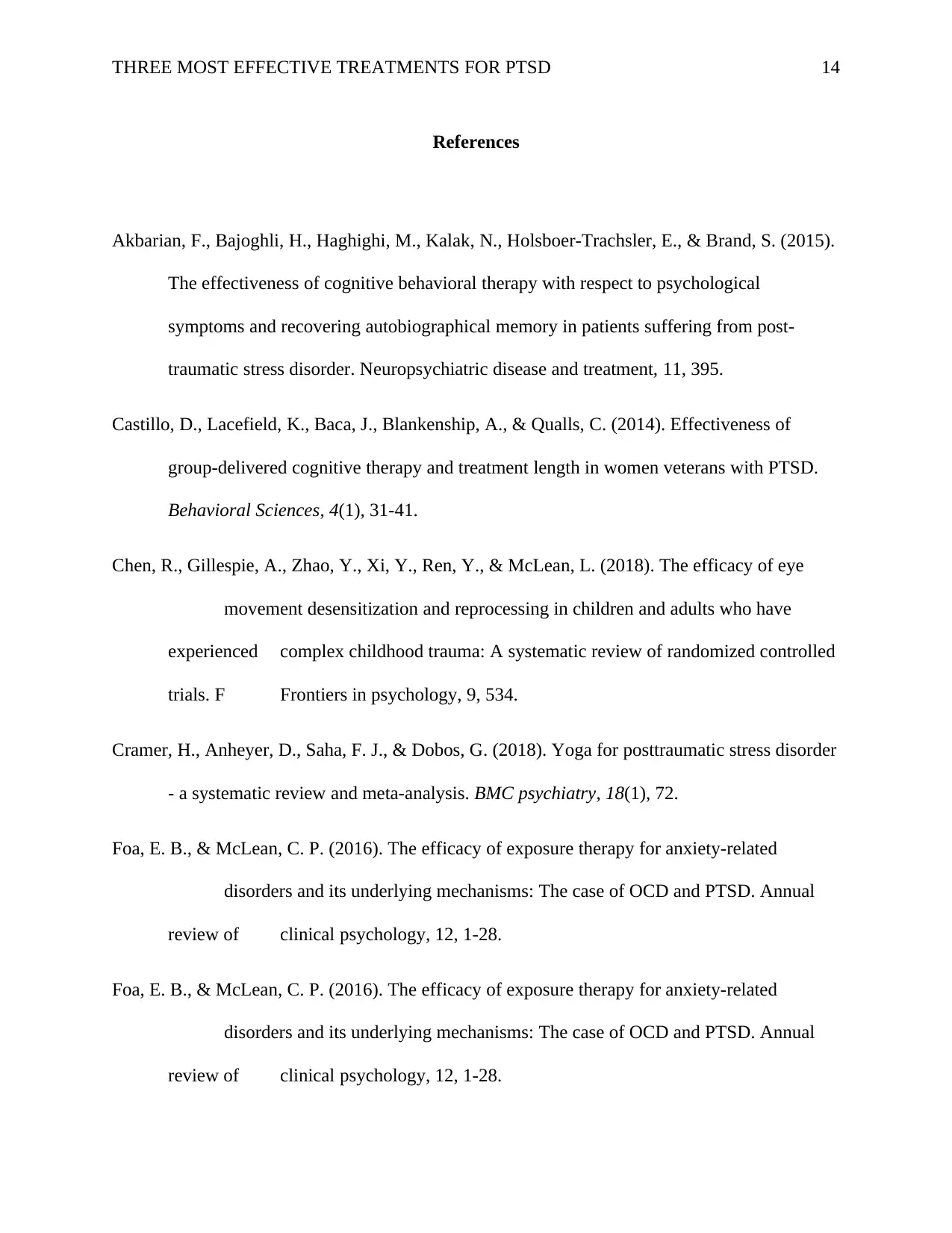
THREE MOST EFFECTIVE TREATMENTS FOR PTSD 14
References
Akbarian, F., Bajoghli, H., Haghighi, M., Kalak, N., Holsboer-Trachsler, E., & Brand, S. (2015).
The effectiveness of cognitive behavioral therapy with respect to psychological
symptoms and recovering autobiographical memory in patients suffering from post-
traumatic stress disorder. Neuropsychiatric disease and treatment, 11, 395.
Castillo, D., Lacefield, K., Baca, J., Blankenship, A., & Qualls, C. (2014). Effectiveness of
group-delivered cognitive therapy and treatment length in women veterans with PTSD.
Behavioral Sciences, 4(1), 31-41.
Chen, R., Gillespie, A., Zhao, Y., Xi, Y., Ren, Y., & McLean, L. (2018). The efficacy of eye
movement desensitization and reprocessing in children and adults who have
experienced complex childhood trauma: A systematic review of randomized controlled
trials. F Frontiers in psychology, 9, 534.
Cramer, H., Anheyer, D., Saha, F. J., & Dobos, G. (2018). Yoga for posttraumatic stress disorder
- a systematic review and meta-analysis. BMC psychiatry, 18(1), 72.
Foa, E. B., & McLean, C. P. (2016). The efficacy of exposure therapy for anxiety-related
disorders and its underlying mechanisms: The case of OCD and PTSD. Annual
review of clinical psychology, 12, 1-28.
Foa, E. B., & McLean, C. P. (2016). The efficacy of exposure therapy for anxiety-related
disorders and its underlying mechanisms: The case of OCD and PTSD. Annual
review of clinical psychology, 12, 1-28.
References
Akbarian, F., Bajoghli, H., Haghighi, M., Kalak, N., Holsboer-Trachsler, E., & Brand, S. (2015).
The effectiveness of cognitive behavioral therapy with respect to psychological
symptoms and recovering autobiographical memory in patients suffering from post-
traumatic stress disorder. Neuropsychiatric disease and treatment, 11, 395.
Castillo, D., Lacefield, K., Baca, J., Blankenship, A., & Qualls, C. (2014). Effectiveness of
group-delivered cognitive therapy and treatment length in women veterans with PTSD.
Behavioral Sciences, 4(1), 31-41.
Chen, R., Gillespie, A., Zhao, Y., Xi, Y., Ren, Y., & McLean, L. (2018). The efficacy of eye
movement desensitization and reprocessing in children and adults who have
experienced complex childhood trauma: A systematic review of randomized controlled
trials. F Frontiers in psychology, 9, 534.
Cramer, H., Anheyer, D., Saha, F. J., & Dobos, G. (2018). Yoga for posttraumatic stress disorder
- a systematic review and meta-analysis. BMC psychiatry, 18(1), 72.
Foa, E. B., & McLean, C. P. (2016). The efficacy of exposure therapy for anxiety-related
disorders and its underlying mechanisms: The case of OCD and PTSD. Annual
review of clinical psychology, 12, 1-28.
Foa, E. B., & McLean, C. P. (2016). The efficacy of exposure therapy for anxiety-related
disorders and its underlying mechanisms: The case of OCD and PTSD. Annual
review of clinical psychology, 12, 1-28.
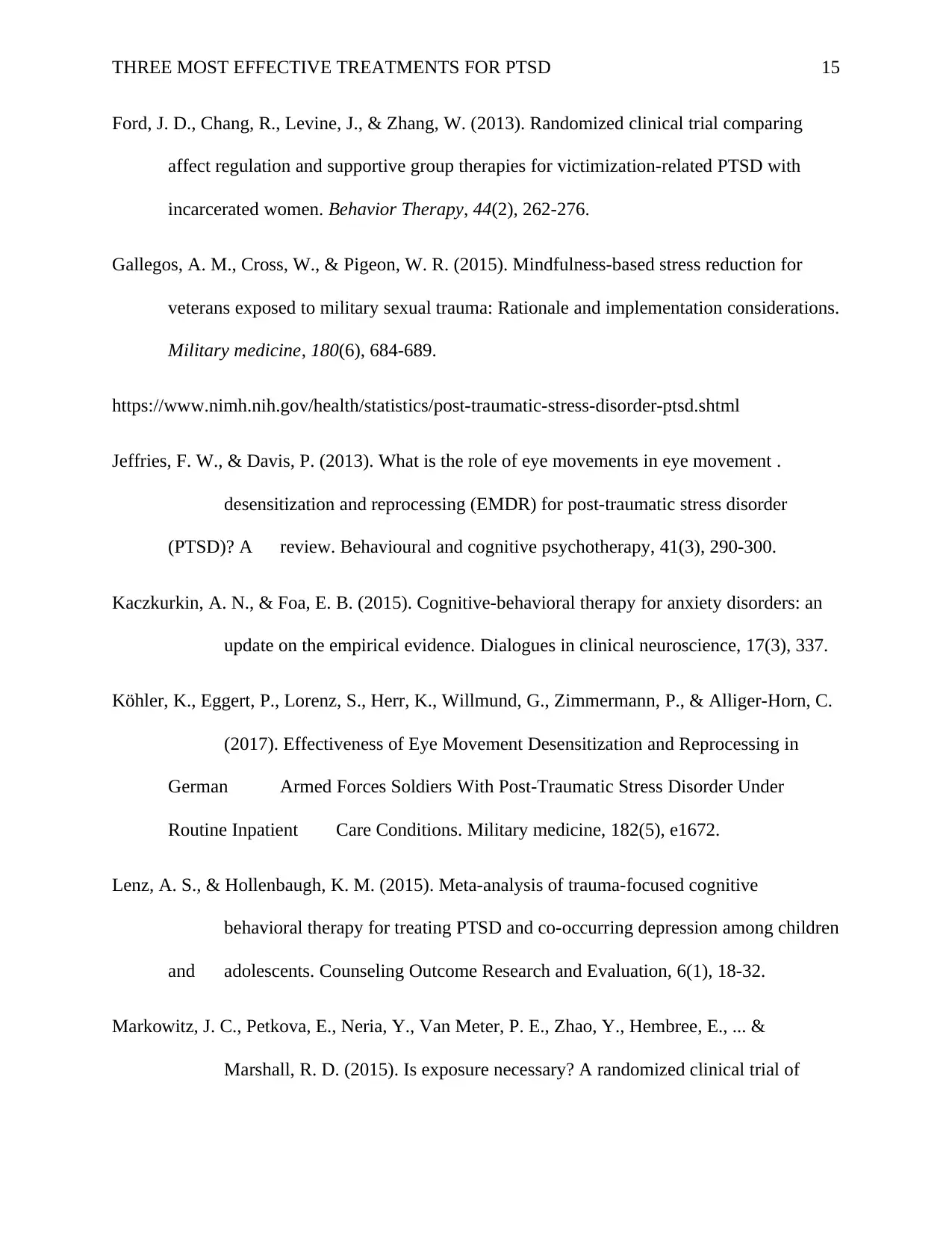
THREE MOST EFFECTIVE TREATMENTS FOR PTSD 15
Ford, J. D., Chang, R., Levine, J., & Zhang, W. (2013). Randomized clinical trial comparing
affect regulation and supportive group therapies for victimization-related PTSD with
incarcerated women. Behavior Therapy, 44(2), 262-276.
Gallegos, A. M., Cross, W., & Pigeon, W. R. (2015). Mindfulness-based stress reduction for
veterans exposed to military sexual trauma: Rationale and implementation considerations.
Military medicine, 180(6), 684-689.
https://www.nimh.nih.gov/health/statistics/post-traumatic-stress-disorder-ptsd.shtml
Jeffries, F. W., & Davis, P. (2013). What is the role of eye movements in eye movement .
desensitization and reprocessing (EMDR) for post-traumatic stress disorder
(PTSD)? A review. Behavioural and cognitive psychotherapy, 41(3), 290-300.
Kaczkurkin, A. N., & Foa, E. B. (2015). Cognitive-behavioral therapy for anxiety disorders: an
update on the empirical evidence. Dialogues in clinical neuroscience, 17(3), 337.
Köhler, K., Eggert, P., Lorenz, S., Herr, K., Willmund, G., Zimmermann, P., & Alliger-Horn, C.
(2017). Effectiveness of Eye Movement Desensitization and Reprocessing in
German Armed Forces Soldiers With Post-Traumatic Stress Disorder Under
Routine Inpatient Care Conditions. Military medicine, 182(5), e1672.
Lenz, A. S., & Hollenbaugh, K. M. (2015). Meta-analysis of trauma-focused cognitive
behavioral therapy for treating PTSD and co-occurring depression among children
and adolescents. Counseling Outcome Research and Evaluation, 6(1), 18-32.
Markowitz, J. C., Petkova, E., Neria, Y., Van Meter, P. E., Zhao, Y., Hembree, E., ... &
Marshall, R. D. (2015). Is exposure necessary? A randomized clinical trial of
Ford, J. D., Chang, R., Levine, J., & Zhang, W. (2013). Randomized clinical trial comparing
affect regulation and supportive group therapies for victimization-related PTSD with
incarcerated women. Behavior Therapy, 44(2), 262-276.
Gallegos, A. M., Cross, W., & Pigeon, W. R. (2015). Mindfulness-based stress reduction for
veterans exposed to military sexual trauma: Rationale and implementation considerations.
Military medicine, 180(6), 684-689.
https://www.nimh.nih.gov/health/statistics/post-traumatic-stress-disorder-ptsd.shtml
Jeffries, F. W., & Davis, P. (2013). What is the role of eye movements in eye movement .
desensitization and reprocessing (EMDR) for post-traumatic stress disorder
(PTSD)? A review. Behavioural and cognitive psychotherapy, 41(3), 290-300.
Kaczkurkin, A. N., & Foa, E. B. (2015). Cognitive-behavioral therapy for anxiety disorders: an
update on the empirical evidence. Dialogues in clinical neuroscience, 17(3), 337.
Köhler, K., Eggert, P., Lorenz, S., Herr, K., Willmund, G., Zimmermann, P., & Alliger-Horn, C.
(2017). Effectiveness of Eye Movement Desensitization and Reprocessing in
German Armed Forces Soldiers With Post-Traumatic Stress Disorder Under
Routine Inpatient Care Conditions. Military medicine, 182(5), e1672.
Lenz, A. S., & Hollenbaugh, K. M. (2015). Meta-analysis of trauma-focused cognitive
behavioral therapy for treating PTSD and co-occurring depression among children
and adolescents. Counseling Outcome Research and Evaluation, 6(1), 18-32.
Markowitz, J. C., Petkova, E., Neria, Y., Van Meter, P. E., Zhao, Y., Hembree, E., ... &
Marshall, R. D. (2015). Is exposure necessary? A randomized clinical trial of
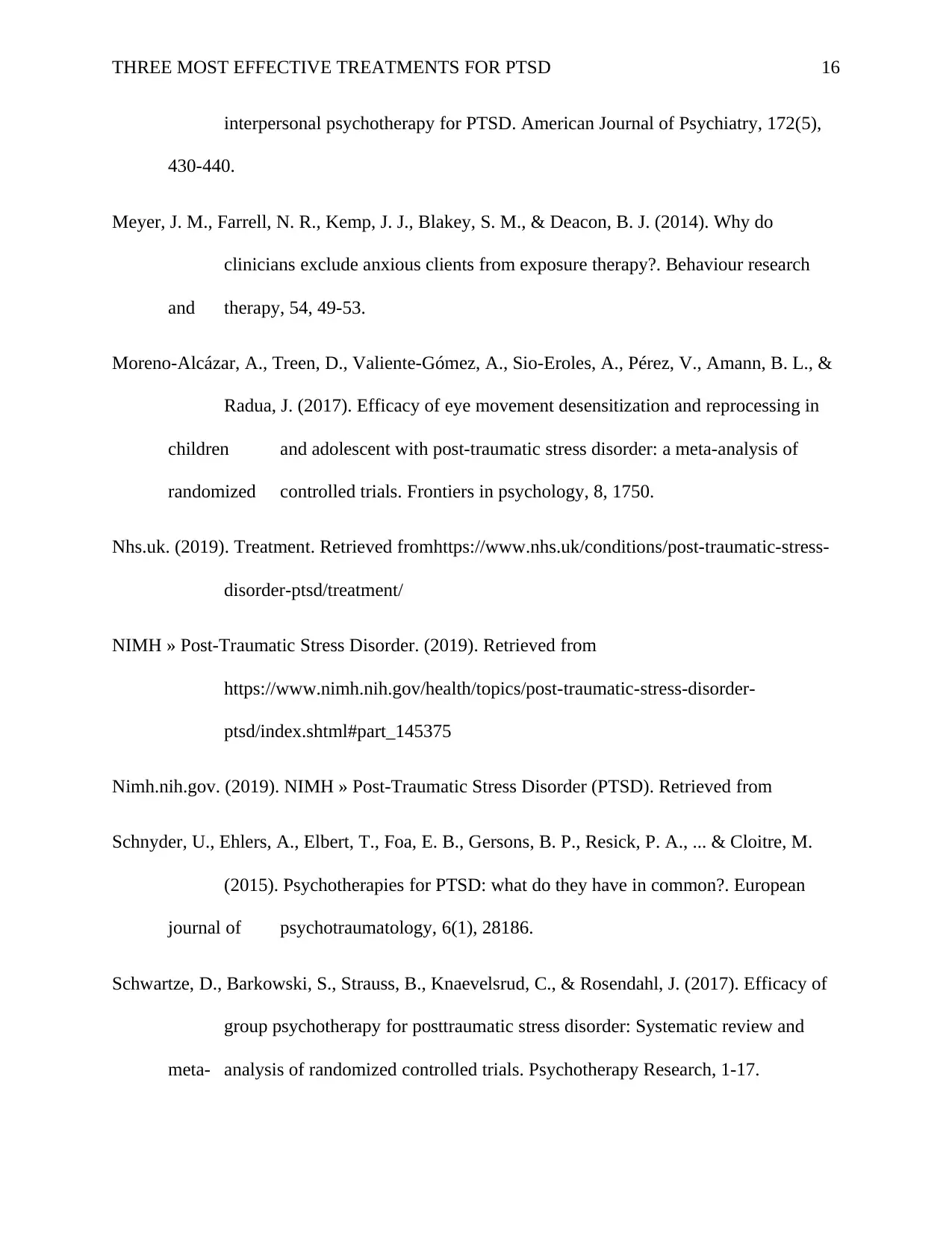
THREE MOST EFFECTIVE TREATMENTS FOR PTSD 16
interpersonal psychotherapy for PTSD. American Journal of Psychiatry, 172(5),
430-440.
Meyer, J. M., Farrell, N. R., Kemp, J. J., Blakey, S. M., & Deacon, B. J. (2014). Why do
clinicians exclude anxious clients from exposure therapy?. Behaviour research
and therapy, 54, 49-53.
Moreno-Alcázar, A., Treen, D., Valiente-Gómez, A., Sio-Eroles, A., Pérez, V., Amann, B. L., &
Radua, J. (2017). Efficacy of eye movement desensitization and reprocessing in
children and adolescent with post-traumatic stress disorder: a meta-analysis of
randomized controlled trials. Frontiers in psychology, 8, 1750.
Nhs.uk. (2019). Treatment. Retrieved fromhttps://www.nhs.uk/conditions/post-traumatic-stress-
disorder-ptsd/treatment/
NIMH » Post-Traumatic Stress Disorder. (2019). Retrieved from
https://www.nimh.nih.gov/health/topics/post-traumatic-stress-disorder-
ptsd/index.shtml#part_145375
Nimh.nih.gov. (2019). NIMH » Post-Traumatic Stress Disorder (PTSD). Retrieved from
Schnyder, U., Ehlers, A., Elbert, T., Foa, E. B., Gersons, B. P., Resick, P. A., ... & Cloitre, M.
(2015). Psychotherapies for PTSD: what do they have in common?. European
journal of psychotraumatology, 6(1), 28186.
Schwartze, D., Barkowski, S., Strauss, B., Knaevelsrud, C., & Rosendahl, J. (2017). Efficacy of
group psychotherapy for posttraumatic stress disorder: Systematic review and
meta- analysis of randomized controlled trials. Psychotherapy Research, 1-17.
interpersonal psychotherapy for PTSD. American Journal of Psychiatry, 172(5),
430-440.
Meyer, J. M., Farrell, N. R., Kemp, J. J., Blakey, S. M., & Deacon, B. J. (2014). Why do
clinicians exclude anxious clients from exposure therapy?. Behaviour research
and therapy, 54, 49-53.
Moreno-Alcázar, A., Treen, D., Valiente-Gómez, A., Sio-Eroles, A., Pérez, V., Amann, B. L., &
Radua, J. (2017). Efficacy of eye movement desensitization and reprocessing in
children and adolescent with post-traumatic stress disorder: a meta-analysis of
randomized controlled trials. Frontiers in psychology, 8, 1750.
Nhs.uk. (2019). Treatment. Retrieved fromhttps://www.nhs.uk/conditions/post-traumatic-stress-
disorder-ptsd/treatment/
NIMH » Post-Traumatic Stress Disorder. (2019). Retrieved from
https://www.nimh.nih.gov/health/topics/post-traumatic-stress-disorder-
ptsd/index.shtml#part_145375
Nimh.nih.gov. (2019). NIMH » Post-Traumatic Stress Disorder (PTSD). Retrieved from
Schnyder, U., Ehlers, A., Elbert, T., Foa, E. B., Gersons, B. P., Resick, P. A., ... & Cloitre, M.
(2015). Psychotherapies for PTSD: what do they have in common?. European
journal of psychotraumatology, 6(1), 28186.
Schwartze, D., Barkowski, S., Strauss, B., Knaevelsrud, C., & Rosendahl, J. (2017). Efficacy of
group psychotherapy for posttraumatic stress disorder: Systematic review and
meta- analysis of randomized controlled trials. Psychotherapy Research, 1-17.
Secure Best Marks with AI Grader
Need help grading? Try our AI Grader for instant feedback on your assignments.
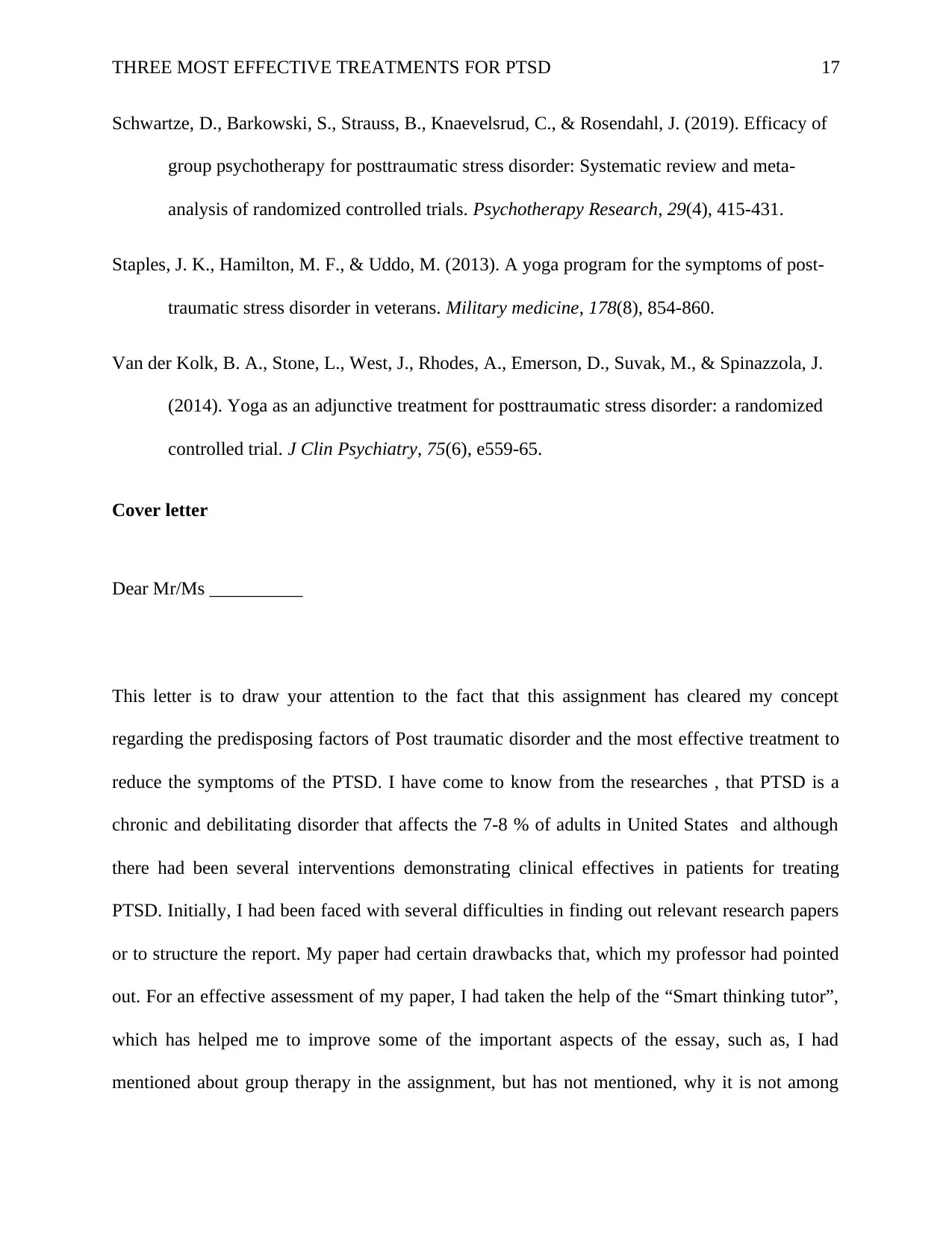
THREE MOST EFFECTIVE TREATMENTS FOR PTSD 17
Schwartze, D., Barkowski, S., Strauss, B., Knaevelsrud, C., & Rosendahl, J. (2019). Efficacy of
group psychotherapy for posttraumatic stress disorder: Systematic review and meta-
analysis of randomized controlled trials. Psychotherapy Research, 29(4), 415-431.
Staples, J. K., Hamilton, M. F., & Uddo, M. (2013). A yoga program for the symptoms of post-
traumatic stress disorder in veterans. Military medicine, 178(8), 854-860.
Van der Kolk, B. A., Stone, L., West, J., Rhodes, A., Emerson, D., Suvak, M., & Spinazzola, J.
(2014). Yoga as an adjunctive treatment for posttraumatic stress disorder: a randomized
controlled trial. J Clin Psychiatry, 75(6), e559-65.
Cover letter
Dear Mr/Ms __________
This letter is to draw your attention to the fact that this assignment has cleared my concept
regarding the predisposing factors of Post traumatic disorder and the most effective treatment to
reduce the symptoms of the PTSD. I have come to know from the researches , that PTSD is a
chronic and debilitating disorder that affects the 7-8 % of adults in United States and although
there had been several interventions demonstrating clinical effectives in patients for treating
PTSD. Initially, I had been faced with several difficulties in finding out relevant research papers
or to structure the report. My paper had certain drawbacks that, which my professor had pointed
out. For an effective assessment of my paper, I had taken the help of the “Smart thinking tutor”,
which has helped me to improve some of the important aspects of the essay, such as, I had
mentioned about group therapy in the assignment, but has not mentioned, why it is not among
Schwartze, D., Barkowski, S., Strauss, B., Knaevelsrud, C., & Rosendahl, J. (2019). Efficacy of
group psychotherapy for posttraumatic stress disorder: Systematic review and meta-
analysis of randomized controlled trials. Psychotherapy Research, 29(4), 415-431.
Staples, J. K., Hamilton, M. F., & Uddo, M. (2013). A yoga program for the symptoms of post-
traumatic stress disorder in veterans. Military medicine, 178(8), 854-860.
Van der Kolk, B. A., Stone, L., West, J., Rhodes, A., Emerson, D., Suvak, M., & Spinazzola, J.
(2014). Yoga as an adjunctive treatment for posttraumatic stress disorder: a randomized
controlled trial. J Clin Psychiatry, 75(6), e559-65.
Cover letter
Dear Mr/Ms __________
This letter is to draw your attention to the fact that this assignment has cleared my concept
regarding the predisposing factors of Post traumatic disorder and the most effective treatment to
reduce the symptoms of the PTSD. I have come to know from the researches , that PTSD is a
chronic and debilitating disorder that affects the 7-8 % of adults in United States and although
there had been several interventions demonstrating clinical effectives in patients for treating
PTSD. Initially, I had been faced with several difficulties in finding out relevant research papers
or to structure the report. My paper had certain drawbacks that, which my professor had pointed
out. For an effective assessment of my paper, I had taken the help of the “Smart thinking tutor”,
which has helped me to improve some of the important aspects of the essay, such as, I had
mentioned about group therapy in the assignment, but has not mentioned, why it is not among
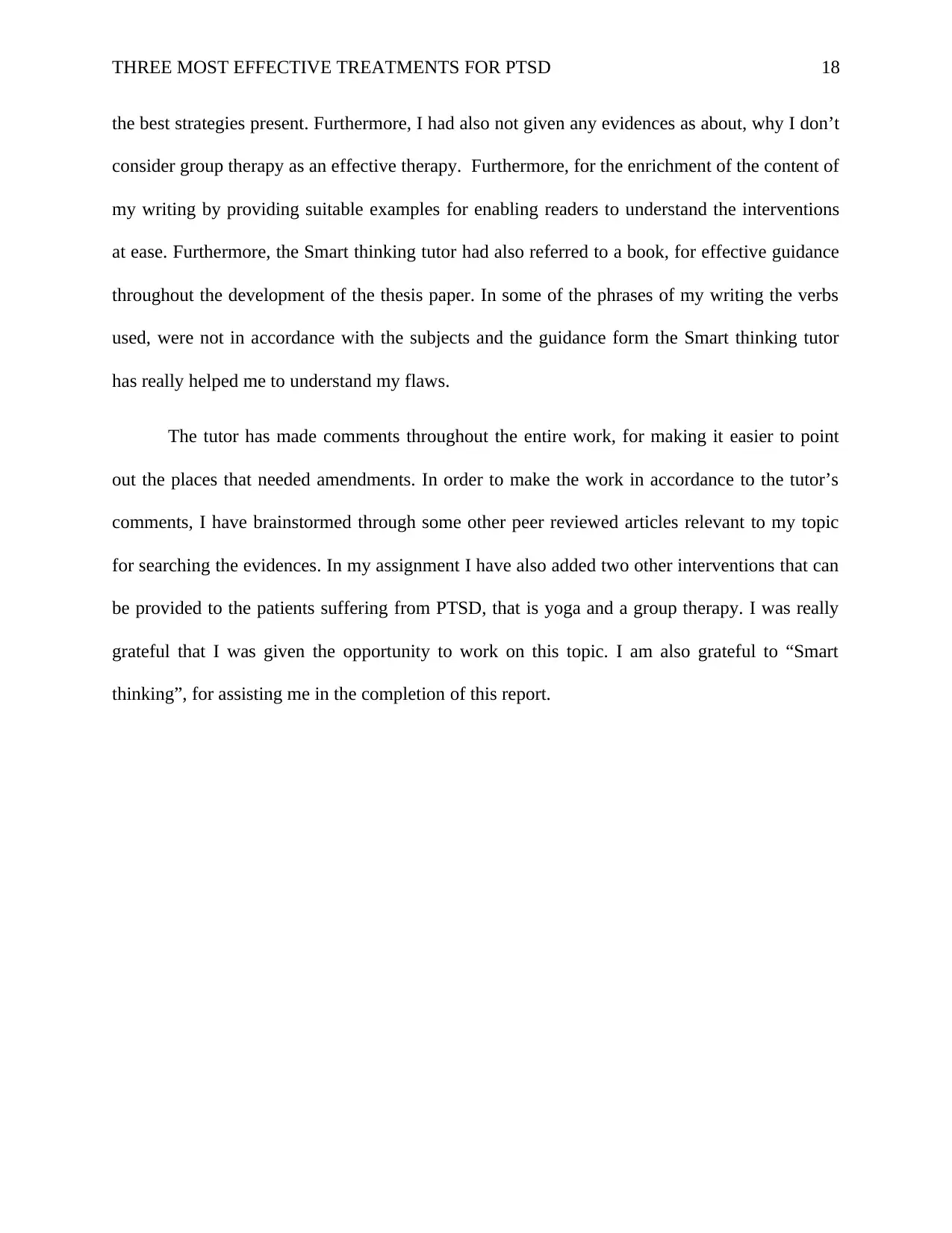
THREE MOST EFFECTIVE TREATMENTS FOR PTSD 18
the best strategies present. Furthermore, I had also not given any evidences as about, why I don’t
consider group therapy as an effective therapy. Furthermore, for the enrichment of the content of
my writing by providing suitable examples for enabling readers to understand the interventions
at ease. Furthermore, the Smart thinking tutor had also referred to a book, for effective guidance
throughout the development of the thesis paper. In some of the phrases of my writing the verbs
used, were not in accordance with the subjects and the guidance form the Smart thinking tutor
has really helped me to understand my flaws.
The tutor has made comments throughout the entire work, for making it easier to point
out the places that needed amendments. In order to make the work in accordance to the tutor’s
comments, I have brainstormed through some other peer reviewed articles relevant to my topic
for searching the evidences. In my assignment I have also added two other interventions that can
be provided to the patients suffering from PTSD, that is yoga and a group therapy. I was really
grateful that I was given the opportunity to work on this topic. I am also grateful to “Smart
thinking”, for assisting me in the completion of this report.
the best strategies present. Furthermore, I had also not given any evidences as about, why I don’t
consider group therapy as an effective therapy. Furthermore, for the enrichment of the content of
my writing by providing suitable examples for enabling readers to understand the interventions
at ease. Furthermore, the Smart thinking tutor had also referred to a book, for effective guidance
throughout the development of the thesis paper. In some of the phrases of my writing the verbs
used, were not in accordance with the subjects and the guidance form the Smart thinking tutor
has really helped me to understand my flaws.
The tutor has made comments throughout the entire work, for making it easier to point
out the places that needed amendments. In order to make the work in accordance to the tutor’s
comments, I have brainstormed through some other peer reviewed articles relevant to my topic
for searching the evidences. In my assignment I have also added two other interventions that can
be provided to the patients suffering from PTSD, that is yoga and a group therapy. I was really
grateful that I was given the opportunity to work on this topic. I am also grateful to “Smart
thinking”, for assisting me in the completion of this report.
1 out of 18
Related Documents
Your All-in-One AI-Powered Toolkit for Academic Success.
+13062052269
info@desklib.com
Available 24*7 on WhatsApp / Email
![[object Object]](/_next/static/media/star-bottom.7253800d.svg)
Unlock your academic potential
© 2024 | Zucol Services PVT LTD | All rights reserved.





